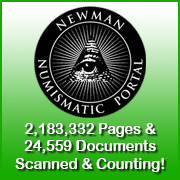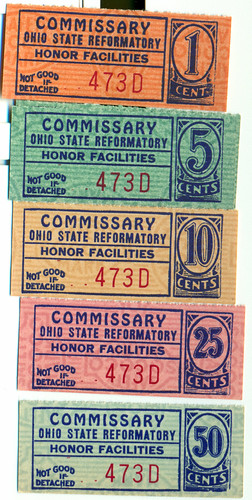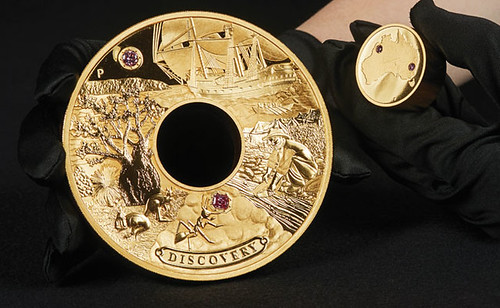
About UsThe Numismatic Bibliomania Society is a non-profit association devoted to the study and enjoyment of numismatic literature. For more information please see our web site at coinbooks.org SubscriptionsThose wishing to become new E-Sylum subscribers (or wishing to Unsubscribe) can go to the following web page link MembershipThere is a membership application available on the web site Membership Application To join, print the application and return it with your check to the address printed on the application. Print/Digital membership is $40 to addresses in the U.S., and $60 elsewhere. A digital-only membership is available for $25. For those without web access, write to: Terry White, Treasurer AsylumFor Asylum mailing address changes and other membership questions, contact Terry at this email address: terrywhite5475@yahoo.com SubmissionsTo submit items for publication in The E-Sylum, write to the Editor at this address: whomren@gmail.com BUY THE BOOK BEFORE THE COINSale Calendar |
- WAYNE'S WORDS: THE E-SYLUM SEPTEMBER 9, 2018
- READER THOUGHTS ON OUR 20TH ANNIVERSARY
- 2018 ANA WORLD'S FAIR OF MONEY EXHIBIT WINNERS
- LARRY SPANBAUER (1942-2018)
- U.S. MINT CORRESPONDENCE SCANNING CONTINUES
- ANS EXPANDS DATA SHARING
- CHARLES WORMSER AND THE MYSTERIOUS SLIDE MARKS
- NOTES FROM E-SYLUM READERS: SEPTEMBER 9, 2018
- BOWERS OFFERS CIVIL WAR PATRIOTIC TOKENS
- REGITKO NUMISMATIC AWARDS MEDALS OFFERED
- THE CEYLON TOKEN OF A.E. SCHMIDT CO.
- HARVEY STACK ON THE 50 STATE QUARTER SERIES
- IS NUMISMATIC INTEREST GROWING?
- VOCABULARY ANNIVERSARY: 100 WEEKS
- VOCABULARY TERMS: PEDIGREE, PROVENANCE
- HENRY DAVENPORT (1811-1898)
- HARVEY STACK'S NUMISMATIC FAMILY, PART 26
- PATRICK RICHEY JOINS WORLD NUMISMATICS, LLC
- THE NUMISMATIC MUSEUM OF ICELAND
- BRAZIL'S NATIONAL MUSEUM BURNS
- PAN 2018 FALL COIN SHOW SCHEDULE
- PAN 2018 FUNDRAISING AUCTION SELECTIONS
- ANA 2019 SHOW DATES
- HERITAGE SEPTEMBER 2018 WORLD & ANCIENTS
- NUMISMATIC NUGGETS: SEPTEMBER 9, 2018
- DETECTORIST FINDS ROMAN COINS NEAR ELLESMERE
- ROMAN COINS FOUND IN YORKSHIRE
- COINS OF THE GILT DRAGON
- 1641 AIRE-SUR-LA-LYS KLIPPE SEIGE COIN
- CANADIAN AND U.S. COIN CACHE FOUND IN YUKON
- MYRTLEWOOD MONEY OF NORTH BEND, OREGON
- ALTCOINS - TODAY'S ALTERNATIVE CRYPTOCOINS
- DISCOVERY: AUSTRALIA MINTS HOLEY DOLLAR TRIBUTE
- THE PERTH MINT RARE EARTH COIN
- HEDY LAMARR JEWISH-AMERICAN HALL OF FAME MEDAL
- SAN DIEGO NEWSPAPER COVERS $20 BROWNBACK SALE
- NATIONAL BANK NOTE LEGAL TENDER STATUS
- INDIA CONSIDERS VARNISHED BANKNOTES
- LOOSE CHANGE: SEPTEMBER 9, 2018
Click here to access the complete archive a
Click here to unsubscribe (scroll down)
To comment or submit articles, reply to whomren@gmail.com
Content presented in The E-Sylum is not necessarily researched or independently fact-checked, and views expressed do not necessarily represent those of the Numismatic Bibliomania Society.
WAYNE'S WORDS: THE E-SYLUM SEPTEMBER 9, 2018
 New subscribers this week include: Peter Lukic, courtesy of John and Nancy Wilson; Steve Hill, and Malcolm Johnson. Welcome aboard! We now have 5,784 subscribers.
New subscribers this week include: Peter Lukic, courtesy of John and Nancy Wilson; Steve Hill, and Malcolm Johnson. Welcome aboard! We now have 5,784 subscribers.
Thank you for reading The E-Sylum. If you enjoy it, please send me the email addresses of friends you think may enjoy it as well and I'll send them a subscription (but let me know if they are located in the European Union). Contact me at whomren@gmail.com anytime regarding your subscription, or questions, comments or suggestions about our content.
This week we open with reader thoughts on our recent anniversary, winning exhibits from the recent ANA World's Fair of Money, but (unusually) there are no new books to report this week.
Other topics this week include Henry Davenport, Charles Wormser, Larry Spanbauer, the 50 States Quarter series, provenance, the numismatic museum of Iceland, the PAN Show, coins of the Gilt Dragon, and the legal tender status of National Bank Notes.
To learn more about the 1976 Assay Commission medal, the Frederick S. Rose gold medal, the unique smell of pennies, French Colonial regulated gold, Myrtlewood Money, the pius, just and invincible King Louis XIII, and Dave Bowers and the Moxie Horesmobile, read on. Have a great week, everyone!
Wayne Homren
Editor, The E-Sylum
READER THOUGHTS ON OUR 20TH ANNIVERSARY
On September 4, 1998 we published our first issue, and here we are two decades later. Here are some reader thoughts on our 20th anniversary. -Editor
Bob Rhue writes:
I hope you are duly proud of what you’ve contributed to Numismatics over the last 20 years. What you do weekly is no small feat, and your commitment and your time are deeply appreciated by many people around the world.
Tom Babinszki writes:
Congratulations for this huge milestone! It is my absolute favorite publication, I am glad it comes each week.
I am a blind coin collector, and my biggest difficulty is that many numismatic publications are printed, which are very difficult to convert into electronic text.
The E-Sylum allows me to get the latest and greatest without much effort. You have turned my Sunday nights into a ritual, I'm waiting for the email to arrive, and I always carve out some time to read it. Your publication alone helped to redefine what numismatics means to me.
I can't thank you enough for your weekly newsletter, and for all your help in the last few years. Please keep up the great work!
Dick Johnson writes:
Take a bow, Wayne, for 20 years of weekly effort in publishing The E-Sylum. Every publication is a reflection of its editor whose curiosity and judgment direct the content.
The numismatic field is fortunate in having you provide the news and information which appears every week! I share the tenant of every reader “We learn something new every week!”
Thanks for all your effort.
Timothy Cook of Busby, MT writes:
Congratulations on your very impressive milestone. I believe I was subscriber number 755. I have kept every issue since my first one and can hardly wait each week for the next. The E-Sylum is without a doubt the best all around numismatic e-newsletter. Everyone in the hobby should feel indebted to you for all that you have done to further research and improve numismatic knowledge for all who are lucky enough to receive your weekly email. Thank you ever so much.
Thanks. Knowing the work is appreciated is what keeps me going. It's never stopped being fun. There's an endless supply of interesting things to learn and people to meet. Keep your input coming! -Editor
To read the earlier E-Sylum article, see:
E-SYLUM ANNIVERSARY: 20 YEARS OF NUMISMATICS (http://www.coinbooks.org/v21/esylum_v21n35a02.html)
2018 ANA WORLD'S FAIR OF MONEY EXHIBIT WINNERS
Drum roll please.... The American Numismatic Association has announced the winners of the exhibit competition at last month's World's Fair of Month in Philadelphia. Of particular interest to NBS members and numismatic bibliophiles in general is Class 17: "Numismatic Literature, Aaron Feldman Memorial. Printed and manuscript (published or unpublished) literature dealing with any numismatic subject."
And the winners are....
First place: Carl Waltz, Jr. for “Publications by Charles T. Steigerwalt.”
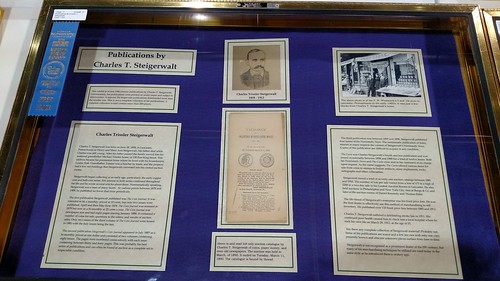
Second place: Michael Shutterly for “Buy the Books for the Coin.”
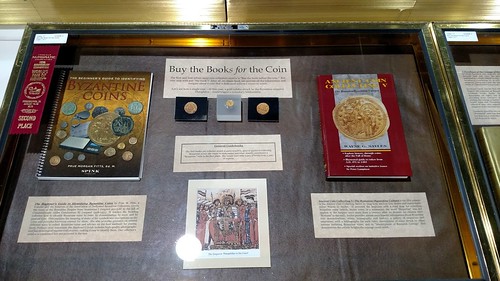
Third place: Darryl Gomez, for “Special Medals for U.S. Government Agencies.”
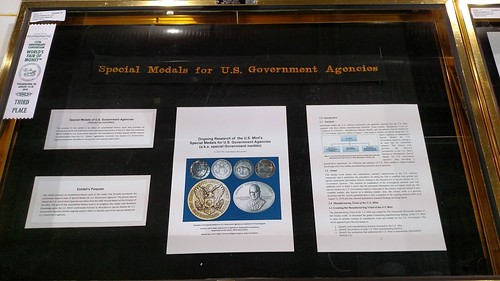
Congratulations! Carl also won First place in United States Coins for “Striking Difference” and Michael Shutterly took home multiple honors including Best-in-Show. Below are highlights from the ANA's Press Release. -Editor
The American Numismatic Association (ANA) presented 55 competitive exhibit awards at the 2018 World’s Fair of Money in Philadelphia, Pennsylvania. Winners were announced at the exhibit awards presentation and reception on Aug. 17, and at the awards banquet that evening.
Thirty-eight exhibitors of all experience levels, showing 51 exhibits, competed in this year’s program. There were also two non-competitive exhibitors showing two additional exhibits.
Michael Shutterly received the Howland Wood Memorial Award for Best-in-Show for his exhibit “Golden Portraits of Byzantium - Every Picture Tells a Story.” The Radford Stearns Memorial Award for Excellence in Exhibiting, presented to the first and second runners-up, was awarded, respectively, to David Menchell for “Medals of the United States Assay Commission 1860 - 1977,” and to Michael Shutterly for “Remember the Ladies - The Empresses of Rome's Severan Dynasty, 193-235.”
The ANA also presented competitive exhibit awards for young numismatists (YNs) age 17 and younger. The Charles H. Wolfe Sr. Memorial Award for the YN Best-of-Show exhibit was presented to Abigail Zechman for “A View of Hobo Nickel Carving Step-by-Step.”
The Thos. H. Law Award for the best exhibit by a first-time exhibitor also went to Ms. Zechman for the same exhibit.
The Rodger E. Hershey Memorial People’s Choice Award, selected by convention attendees, was also won by David Menchell for his exhibit of Assay Commission medals.
Michael Shutterly also received the Women in Numismatics award for his exhibit “Remember the Ladies: The Empresses of Rome’s Severan Dynasty, 193-235.”
V. Kurt Bellman received the Derek Pobjoy Award for Best Exhibit of Modern Circulating Commemorative Coins for his exhibit “The Beginning of U.S. Nickel Coinage - A Local Story.”
Mr. Shuttterly also received the Ira & Larry Goldberg Award for the best exhibit of “Coins that Made History” for “Watch Your Head! Helmets From the Iron Age to the Space Age.”
Robert F. Fritsch received the Joseph E. Boling Award for Judging Excellence.
Congratulations to the winners and many thanks to all the exhibitors, judges and volunteers for their hard work. Job well done!
Above are images of the first case in each multi-case exhibit. To see photos of the remaining cases, visit our Flickr album here: 2018 ANA Exhibits (https://www.flickr.com/photos/coinbooks/albums/72157700358962155). -Editor
To read the complete press release, see:
Exhibitors Honored at Philadelphia World’s Fair of Money®
(https://www.money.org/uploads/pdfs/Exhibitors%20Honored%20at%20WFM.pdf)
Our webmaster Bruce Perdue has begun working to add the 2018 exhibits to the NBS web site. Michael Shutterly has provided the text and additional images for his exhibit, and we hope to work with the other exhibitors as well. -Editor
Bruce writes:
The following years do not have any numismatic literature entries on our site: 2016, 2015, 2014, 2013, 2012, 2010, 2009, 2008, 2006.
Perhaps E-Sylum readers might know if there were exhibits in those years and provide the information.
To view Michael Shutterly's exhibit, see:
"Buy the Books for the Coin" (http://www.coinbooks.org/about/shutterly_exhibit.html)
To view earlier literature exhibits, see:
Numismatic Literature Exhibits (http://www.coinbooks.org/about/exhibit_winners.html)
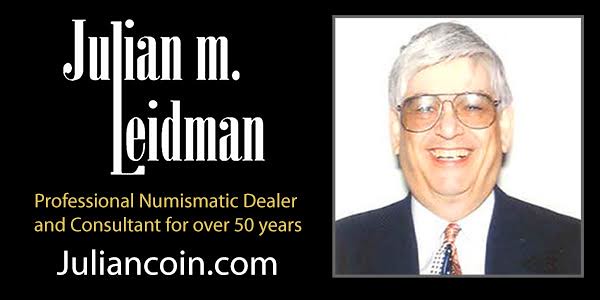
LARRY SPANBAUER (1942-2018)
Jeff Reichenberger submitted this obituary for author Larry Spanbauer. Sorry to hear the news. Thank you. -Editor
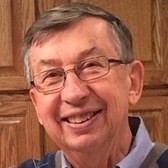 Former United States Assay Commissioner and Numismatic author, Larry Spanbauer passed away on September 4th at the age of 75. He was born on November 1, 1942 in Oshkosh,
WI and lived there his entire life.
Former United States Assay Commissioner and Numismatic author, Larry Spanbauer passed away on September 4th at the age of 75. He was born on November 1, 1942 in Oshkosh,
WI and lived there his entire life.
Larry was one of the leading counterfeit experts in the 1970’s. In 1975 he self-published the book, Colonial Copies, Private Mint Replicas, Modern Counterfeits of United States Coins. He wrote the “Focusing on Fakes” column for Numismatic News (1976–1978). In 1976 he was appointed to the United States Assay Commission by President Gerald Ford. In 1979 he and co-author Virgil Hancock wrote the Standard Catalog of United States Altered and Counterfeit Coins, published by Durst. The first catalog of its type and very useful for the time, however, Larry became disenchanted with the publisher and the process and he ultimately retreated from the hobby. He became a leading scholar and memorabilia expert of Oshkosh, Wisconsin history.
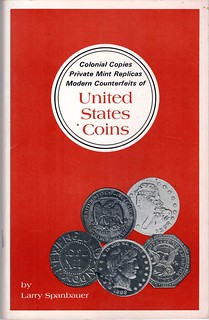
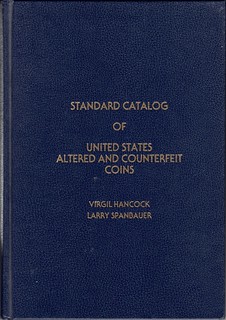
Larry’s interest in numismatics started in 1967 when his grandmother showed him her large accumulation of old coins. He went on to serve as president of both the Oshkosh Coin Club and the Numismatists of Wisconsin, also as the editor of that organization’s quarterly magazine, NOW NEWS. During the early seventies he turned his interest from genuine United States coins to the spurious variety, selling or trading most of his genuine coin collection to obtain the counterfeit pieces necessary to help facilitate the publishing of his first book.
I became acquainted with Larry perhaps 20 years ago when we would see each other at the annual Oshkosh Coin Show. I began helping set up the shows and Larry would occasionally set up a display of Oshkosh memorabilia, sometimes non-numismatic, but his tables were always fascinating for Oshkosh residents. Larry loved to educate people about the town’s past.
In 2012 he wrote the book Oshkosh Neighborhood Taverns and in 2015 he wrote a book about the Oshkosh Cigar Industry, and he set up a four-table display on the subject at the coin show, including piles of wooden cigar boxes from the 1800’s. Some of the cigar company’s owners were prominent Oshkosh businessmen that had their hands in other projects that struck tokens for various reasons – these tokens were also on display to tie in the numismatic angle.
At the 2016 show, Larry set up a display commemorating the 40th anniversary of the last Assay Commission, of which he was a member. There were his letters of appointment, photos, documents of recognition, and of course his medal. Again, his tables were inundated with interested people. Larry was understandably proud of his appointment.
I was lucky enough to collaborate with Larry on a number of small articles for NOW NEWS, and he would occasionally call me when he had an interesting piece to perhaps write about. I enjoyed going over to his home and spending hours looking over his meticulously arranged and organized notebooks, articles, documents, coins, and tokens. A couple years back he decided to part with most of the coins and tokens, simply putting them in a rummage sale. He afforded me the chance to get first dibs on a number of items which I hold dear. Larry was just a super-nice, genuine man of integrity, generosity, and spirit and he will be sorely missed.
The 1976 Assay Commission medal was engraved by Frank Gasparro; it features Treasury Secretary William Simon on the obverse and Washington Crossing the Delaware on the reverse. Here are images found on the CoinAppraiser.com web site, followed by more photos of Larry provided by Jeff. -Editor

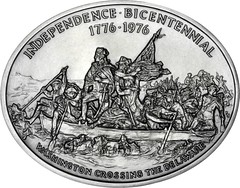
(From: http://coinappraiser.com/coins/1976-u-s-assay-commission-medal/ )
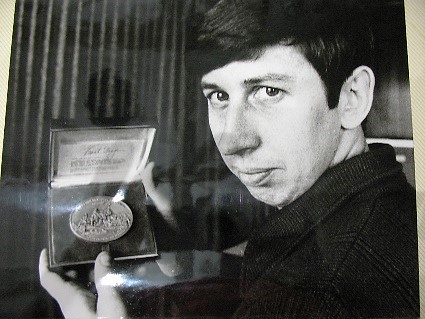
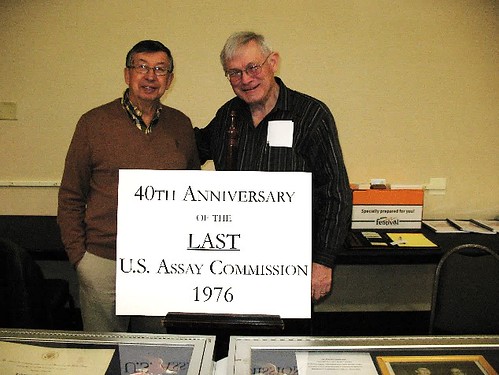
Larry's two books were for years the most heavily used in my library. Quite handy when dealing with the general public. I was asked once to examine what someone thought was a genuine and valuable rarity. I've since forgotten what it purported to be. But I told the party up front what we would do. I would have two books and a scale. When they arrived at my house I opened a Red Book and pointed to the entry for the coin and noted the weight of a genuine issue. Then I opened the Spanbauer book to see the weights of the known fakes. I let them put it on the scale and - no surprise - it was a fake.
It was a loss to the numismatic world when he pulled back. Larry was one of the Good Guys. Here's an excerpt from his online obituary. -Editor
Lawrence "Larry" Spanbauer passed away on Tuesday, September 4, 2018 at the age of 75 due to complications from heart failure. He was born in Oshkosh on November 1, 1942, the son of Lawrence "Barney" Spanbauer and Margaret Fretschel. On February 9, 1963 he married the former Carol Jean Ames. Larry was the embodiment of Oshkosh citizenship through his education, work and volunteerism.
Larry attended Sacred Heart Grade School, Oshkosh High School and the University of Wisconsin - Oshkosh and was employed by Rockwell International for 36 years and then Curwood-Bemis part time for 14 years
Larry was on the Board of Directors of the Wisconsin Axle/Citizens First Credit Union for 25 years and was the Recording Secretary for UAW Local 291 - (Rockwell) for six years. He was part of the Carl Traeger School Referendum Committee, Chaired the East Side Firehouse Relocation Committee, was a member of the Lakeshore Golf Course Committee and Chaired the Oshkosh Gateway Committee.
To read the complete article, see:
Lawrence Spanbauer
(https://www.legacy.com/obituaries/thenorthwestern/obituary.aspx?n=lawrence-spanbauer&pid=190150981)
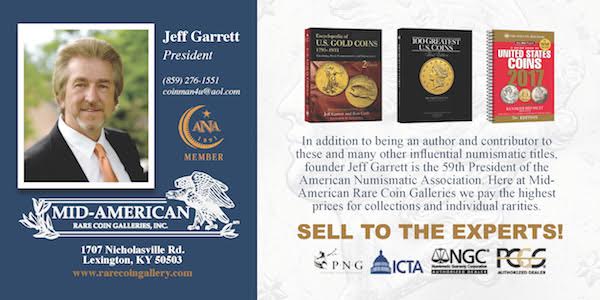
U.S. MINT CORRESPONDENCE SCANNING CONTINUES
The latest addition to the Newman Numismatic Portal is additional U.S. Mint General Correspondence into the 1860s. Project Coordinator Len Augsburger provided the following report. Thanks. -Editor
U.S. Mint General Correspondence Scanning Continues
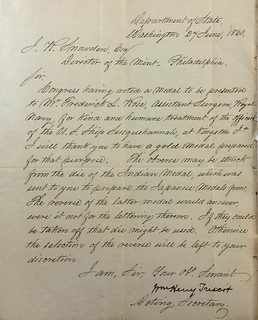 Several years ago, Bob Julian directed the scanning of the U.S Mint general correspondence files (record group 104, entry 1) at the National Archives & Records
Administration (NARA) in Philadelphia. Operating under a grant from the Central States Numismatic Society (CSNS), Julian coordinated the delivery of the first 45 boxes of this
series, covering the years 1792-1857.
Several years ago, Bob Julian directed the scanning of the U.S Mint general correspondence files (record group 104, entry 1) at the National Archives & Records
Administration (NARA) in Philadelphia. Operating under a grant from the Central States Numismatic Society (CSNS), Julian coordinated the delivery of the first 45 boxes of this
series, covering the years 1792-1857.
Comprising over 20,000 pages, this material allows researchers to go directly to the source rather than having to travel to remote locations to study these original working documents from the U.S. Mint. The Newman Portal is extending this work and has added volumes into the 1860s. John Graffeo, who previously worked in the library of the American Numismatic Society, is continuing the scanning effort in Philadelphia.
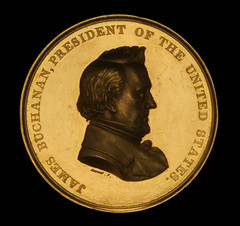

The Frederick S. Rose gold medal (obverse Julian IP-36)
In randomly browsing one of the recently-scanned correspondence volumes, I chanced upon an 1860 letter from William Henry Trescot (Assistant Secretary of State) to U.S. Mint Director James Ross Snowden. The letter orders the striking of a gold model for Frederick S. Rose, a Royal Navy surgeon, acknowledging his efforts in treating an outbreak of yellow fever on the USS Susquehanna while in Jamaica. So, was the medal actually struck? Indeed it was, and a quick check of the Newman Portal finds the medal in the collection of Alan Weinberg. Weinberg notes that this was the first congressional gold medal awarded to a recipient outside the U.S. – a signal honor. The correspondence reads as follows:
“Congress having noted a medal to be presented to Mr. Frederick S. Rose, Assistant Surgeon, Royal Navy, for kind and humane treatment of the officials of the U.S. Ship Susquehannah, at Kingston Ja[maica] I will thank you to have a gold medal struck for that purpose. The obverse may be struck from the die of the Indian Medal {Julian IP-36], which was sent to you to prepare the Japanese medals from. The reverse of the latter medal would answer, were it not for the lettering thereon. If they could be taken off that die might be used. Otherwise the selection of the reverse will be left to your discretion.”
Link to U.S. Mint general correspondence group on Newman Portal:
https://nnp.wustl.edu/library/archivedetail/515202
COIN WORLD
The addition of Coin World to the Newman Numismatic Portal, announced last week, was another landmark event for numismatic research. Over 300,000 pages of numismatic
content are now fully searchable. Users are already beginning to utilize it. -Editor
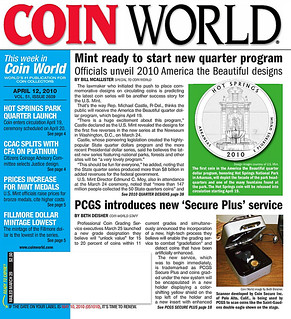 Barbara Robinson at Littleton Coin Company writes:
Barbara Robinson at Littleton Coin Company writes:
What a great resource and worthwhile addition to the project. This is great! Last week I was looking for the Coin World article announcing the discovery of the 1938 D over S Buffalo but gave up. Using this tool it took me less than a minute to locate the correct issue. It’s a front page article in the March 16, 1962 Coin World. Awesome.
To read the earlier E-Sylum article, see:
COIN WORLD AVAILABLE IN NEWMAN PORTAL SEARCHES (http://www.coinbooks.org/v21/esylum_v21n35a06.html)

ANS EXPANDS DATA SHARING
A note in the August 2018 American Numismatic Society E-NEWS discussed how the ANS is sharing art museum data. -Editor
MANTIS now publishes data conforming to the linked.art specification, which is a community-driven effort to standardize art museum data. It will in theory enable the ANS to make certain portions of its collection available into projects such as the American Art Collaborative, for example, medals engraved, sculpted, or otherwise designed by famous American artists
For more information, see:
MANTIS (http://numismatics.org/search/)
The American Art Collaborative (http://americanartcollaborative.org/)
CHARLES WORMSER AND THE MYSTERIOUS SLIDE MARKS
Alan Weinberg writes:
I knew Charles Wormser from my early New Jersey days visiting New Netherlands on 44th St NYC. He was the spitting image of his dad Moritz Wormser.
I recall lot examination of some rare colonials including a choice 1790 Standish Barry 3d in an early 1960s New Netherlands auction and noticed on many colonials bright fresh slide marks on the coins, pointing them out to a concerned Charles W. We determined the source of these bright fresh apparent slide marks. The NN catalogue photographer was sliding the coins off the sharp edge of the photography glass. Back in those days, there were no slabs.
Scary! Glad the practice was caught. Thanks. We don't seem to have had a photo of Charles Wormser before. I located one on the PCGS site (in Dave Bowers' Abe Kosoff: Dean of Numismatics book) and cropped it from a group photo. Here he is side-by-side with his father. Alan's right - spitting image! -Editor
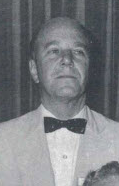
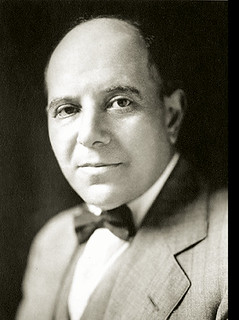
Charles and Moritz Wormser
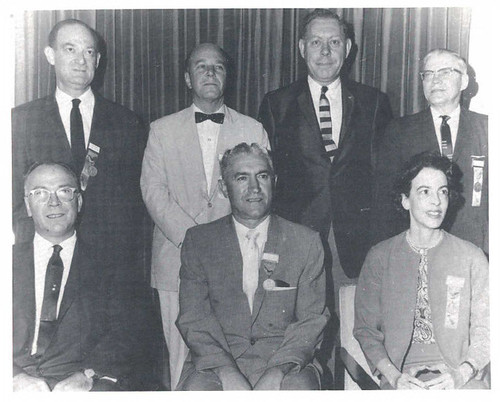
A 1964 photograph of directors and officers of the Professional Numismatists Guild. In the back row, standing, left to right: Lester Merkin, Charles Wormser, Dan Brown, Ben Dreiske; in the front row: Leo Young, Abe Kosoff (president at the time), Catherine Bullowa.
To see the image on the PCGS site, see:
Abe Kosoff: Dean of Numismatics (https://www.pcgs.com/books/abekosoff/Chapter10-014.aspx)
To read the earlier E-Sylum article, see:
THE ANA'S MORITZ WORMSER MEMORIAL COLLECTION (http://www.coinbooks.org/v21/esylum_v21n35a15.html)
See the article NOTES FROM E-SYLUM READERS later in this issue for Alan's recollection of Abe Kosoff. -Editor
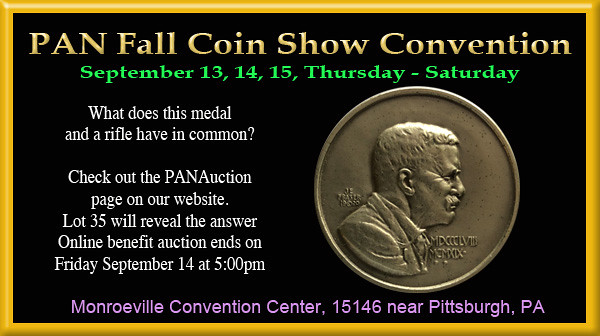
NOTES FROM E-SYLUM READERS: SEPTEMBER 9, 2018
Abe Kosoff's Pricey Coins
Alan Weinberg writes:
 One more comment on Abe Kosoff (pictured in the previous article with Charles Wormser). I recall standing next to AK on the floor of a major coin show, likely the ANA or
the NYC Metropolitan show at the 57th Street Parke Sheraton, at that time the 2nd most prominent numismatic show after the ANA.
One more comment on Abe Kosoff (pictured in the previous article with Charles Wormser). I recall standing next to AK on the floor of a major coin show, likely the ANA or
the NYC Metropolitan show at the 57th Street Parke Sheraton, at that time the 2nd most prominent numismatic show after the ANA.
AK used to, at least in the early 60s, put out only 1 or 2 eye-opening coins in his case for sale, not even priced visibly. He was rather haughty in his stance in my opinion (unlike the highly approachable Lester Merkin), and I guess AK thought "if you have to ask the price, you can't afford it".
Well, I distinctly recall this time he had an ultra high-relief Roman numeral 1907 $20 in his case marked "available". Though not posted, the price was $250,000 about the time an 1804 dollar was auctioning for $29K. And a couple of years after I turned down the Brand Brasher Doubloon for $14K from Dick Picker.
AK was always rather high-priced as he largely dealt with an exclusive and wealthy clientele, not the average collector.
Dansco Panama Album #7451 Found
Last week John Okerson wrote:
If anyone has the Dansco Panama album #7451 (not the Panama Type, which is #7452), please contact me at johnokerson@gmail.com .
John adds:
Thanks to the posting, I know of three folks who noticed the text regarding my desire. David Lange owns but one of the albums, but Brian Stickney had two versions of the one I want and is sending me the older one gratis! He asked that I make a donation to our local coin club – funny since I am currently the President through 2019. .
Thanks! E-Sylum readers are the best. -Editor
To read the earlier E-Sylum article, see:
NOTES FROM E-SYLUM READERS: SEPTEMBER 2, 2018 : Dansco Panama Album #7451 Sought
(http://www.coinbooks.org/v21/esylum_v21n35a09.html)
Glass 1964 Coin Plates
Ken Berger of San Diego writes:
I also have the same commemorative plate as Dave Hirt's. I bought mine from a fellow collector, Ken Stempien, a few years ago.
In addition, I have another plate. This plate, rather than have coin impressions, has the actual coins. All are dated 1964. The center has an impression of a heraldic eagle. Along the top of the plate, it says "UNITED STATES OF AMERICA", while along the bottom is "IN GOD WE TRUST". This plate was originally owned by my father.
Thanks. Ken included an image of the latter plate. Here are images of the plates side-by-side. -Editor

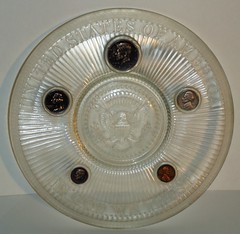
LEFT: plain glass plate; RIGHT: plate with embedded coins
To read the earlier E-Sylum article, see:
NOTES FROM E-SYLUM READERS: SEPTEMBER 2, 2018 : Dave Hirt's Yard Sale Finds
(http://www.coinbooks.org/v21/esylum_v21n35a09.html)
Prison Money Publication in the Works
After last week's mention of prison money, I reached out to Bob Hewey about the status of the cataloguing effort he'd mentioned earlier. -Editor
As a matter of fact, progress is being made! I am collaborating with Jim Delaney on what we hope will be a free online-only publication. We hope to complete in late 2018 or early 2019.
That's great news! We'll look forward to its announcement. -Editor
To read the earlier E-Sylum articles, see:
AN APPROACH FOR CATALOGUING PRISON SCRIP (http://www.coinbooks.org/esylum_v17n21a16.html)
NOTES FROM E-SYLUM READERS: SEPTEMBER 2, 2018 : Notes on Tokens
(http://www.coinbooks.org/v21/esylum_v21n35a09.html)
Counterstamps and Chopmarks
Taylor Leverage of Baltimore, MD writes:
I am a collector of chopmarked coinage, and had no idea that Mr. Brunk was still alive. I would like to put him in touch with Colin Gullberg, the editor of the Chopmark News, to try to put some quotes and perhaps a brief interview with Mr. Brunk into the next issue of the News.
Great idea! I put Taylor in touch with Mr. Brunk via Bill Groom. Meanwhile, Taylor shares this cross-interest coin, an 1860-S bearing a merchant counterstamp of unknown origin, as well as Chinese chopmarks. Thanks. Interesting piece. If coins could talk! -Editor
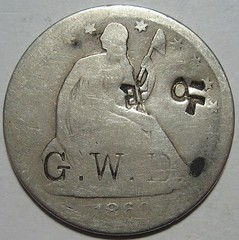
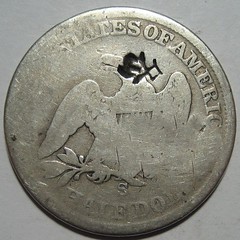
Jeff Rock of San Diego writes:
I saw the notice in the last issue about Gregory Brunk's third edition. One possibility is to do what we did with the counterfeit halfpenny book that came out a few months back -- Print On Demand. While it requires an initial investment to get things ready, the sale of the books would pay that back fairly quickly (or one would hope). Surely a club like TAMS would be able to provide some or all of the seed money needed for the project once the photographs are inserted where they need to be. As long as great profits aren't expected to be made, this is a good way to go -- the book can be done in full color and priced at under $100.
The other option is to look at making the book a website, perhaps on the Wiki format where collectors can make additions and changes. This would of course save the costs of printing and postage, and would allow the work to grow over time without going into further printed editions. Having something like this open to the public to view (but with verification needed to make actual changes) would probably do wonders for the hobby, as new collectors could find it with a Google search and get engrossed in the site and excited about the field! The Newman Portal could also likely link to it if someone searches for counterstamped US coins...
Can anyone help? I did notify the officers of the Token and Medal Society (TAMS). Two readers have also come forth with offers to pitch in on the costs of publication. It's a great project that seems to have legs. It would be great to see the new edition get published in one format or another. -Editor
To read the earlier E-Sylum article, see:
BRUNK MERCHANT COUNTERMARKS PUBLISHER SOUGHT (http://www.coinbooks.org/v21/esylum_v21n35a08.html)
Leatherbound French Catalogs Sought
Jan Valentine writes:
I'd like ask our readers how many of them have a leather bound Dr. French catalog? To my knowledge no one has tried to find out how many are out there. Also whether there is a name on the front cover.
Can anyone help? Dr. George French of Rochester, N.Y., sold his collection of large cents to dealer B. Max Mehl for a reported $50,000 in 1929. Mehl published a fixed-price catalog in May 1930. -Editor
Wheat Cent Circulation Find
Tim Farricy of Syracuse NY writes:
I had a surprising find this week. While taking my change from one of those machines that dispenses coins while the clerk handles the bills, I discovered two wheat pennies. They won't fund my retirement, but it was unexpected. 1942, and 1950-D.
When I was a kid wheat cents where everywhere, but now they're scarce as hen's teeth in circulation. Nice little find. -Editor
A Signed Breen Encyclopedia
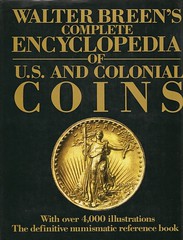 Craig McDonald writes:
Craig McDonald writes:
I enjoyed reading the recent articles about Breen's Encyclopedia and the marketing/distribution/sale of them.
I pulled my copy off the shelf and looked inside the front cover. My copy was purchased at the New Jersey (GSNA?) show on 6/24/88 and is signed and numbered as the 120th copy sold there.
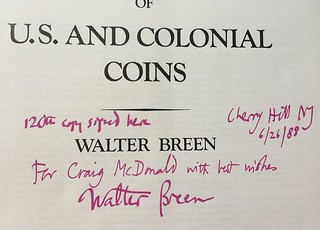
To read the earlier E-Sylum article, see:
SELLING BREEN'S COMPLETE ENCYCLOPEDIA (http://www.coinbooks.org/v21/esylum_v21n35a14.html)
Club Supports Young Numismatist Travel Expenses
John Ferreri of the Mansfield Numismatic Society writes:
The MNS has realized that youngsters often cannot participate in Young Numismatist events because they need a parent or two to support them. The MNS is in Connecticut and there is a very good YN program in New Hampshire twice a year at the regional new England Numismatic Association (NENA) show. The trouble is: Mom or Dad can't afford to take time off from work to bring the YN 150 or so miles to a "coin show".
So, the Mansfield (Connecticut) Numismatic Society has stepped in to support these kids with a scholarship to help pay the expense occurred in staying overnight at the convention hotel. We also support the Boy Scouts and soon, the Girl Scouts with funds for a day trip. The show promoter and a coin dealer combine to enroll all these YNs in the ANA for a year's membership. This will be our (MNS) second year supporting these YNs, our future numismatists.
For more information about our initiative and how your club can also make an impact with your local Y.N.’s, please contact us at: oldmoneyinfo@yahoo.com or at P.O. Box #33 Storrs, CT 06268.
Great program! -Editor
Penny Smell Word Jumble
Dick Johnson found another numismatic word Jumble puzzle for us. Thanks. Try it out! -Editor
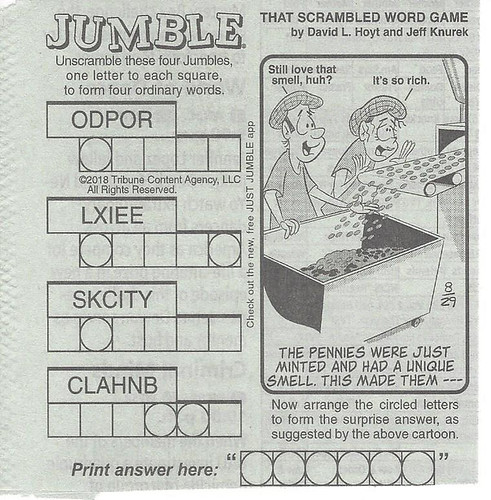
To read the earlier E-Sylum article, see:
NOTES FROM E-SYLUM READERS: SEPTEMBER 2, 2018 : Buffalo Nickel Word Jumble Answer
(http://www.coinbooks.org/v21/esylum_v21n35a09.html)

BOWERS OFFERS CIVIL WAR PATRIOTIC TOKENS

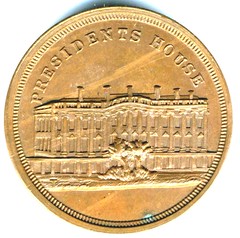
Dave Bowers is updating a private for-sale listing of Civil War tokens collected over the past 50 years. His list to be available Wednesday includes the largest offering of 1860 patriotic tokens and mulings in numismatic history, including those of Lincoln, Bell, Breckinridge, and Douglas. Also many other types with Civil War motifs. If you would like a free listing e-mail Dave at qdbarchive@metrocast.net.
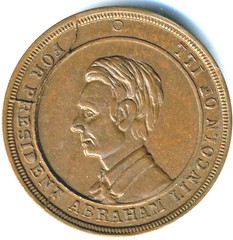

*506A/507a • Lincoln / Lincoln • Copper PE • R-10, unique! • MS-64 BN (PCGS) • $4,750
With Lincoln on both sides, one side with a crack, showing it was about to be retired when 506A was created, but it also cracked and was short-lived! Discovered by the writer on September 19, 2005, when examining purchases from the Andrew C. Zabriskie Collection, where it had remained undetected for over a century (in the 19th century dies were not classified).
Obverse die state: Details of portrait shallow. Large crack from border down to above top of F (FOR); large crack from border through left side of T (PRESIDENT); crack from border through right side of H (ABRAHAM). •
Reverse die state: Crack from border past period (ILL.), through inner circle, and ending at top of ear. Crack from border through 2nd E (PRESIDENT), through inner circle, to point close to lower lip. Crack from border to lower right of C (LINCOLN). • Data: 0°. 81.3 grains, 21.7 mm

REGITKO NUMISMATIC AWARDS MEDALS OFFERED
John Regitko submitted this follow-up to his earlier article. Thank you. -Editor
 A few weeks ago, you published my write-up about disposing of awards medals, where 100% of the proceeds would be donated to charity. Half would go to numismatic
charities, the other half to other registered charities).
A few weeks ago, you published my write-up about disposing of awards medals, where 100% of the proceeds would be donated to charity. Half would go to numismatic
charities, the other half to other registered charities).
I asked for comments and received exactly one. It was from Geoff of Geoffrey Bell Auctions of Moncton, NB, who thought that was a good way of getting these medals into the hands of someone else that would appreciate them. He even committed that if they were chosen as the auctioneer, they would donate 100% of the commissions to a numismatic charity.
I have consigned 58 of my awards medals to their upcoming auction held in conjunction with Coin Expo, scheduled for September 28 - 29, 2019 at the convention facility of the Toronto Reference Library in downtown Toronto. Most of them were awarded to me by the Ontario Numismatic Association, with a number also from the Canadian Numismatic Association. It also includes the Ferguson Medal, the highest award in Canadian numismatics, which is a gold-plated silver medal.
In addition, my wife, who had also been involved with the CNA/RCNA and Ontario Numismatic Association conventions and local coin clubs, has consigned 15 of her awards. These consist of a number of silver and some bronze medals engraved with her name and title indicating her responsibility.
I have been involved for well over 50 years as a collector (mainly Canadian error coins), volunteering my time at all levels and various positions. I have great memories of my involvement. Although I will always greatly value those memories, they do not depend on the physical possession of the medals.
Even though my wife had been involved with organizing of conventions, her knowledge of all things numismatic is minimal. I therefore thought it best to organize and plan the disposition of my collection, including the awards, while I am still able to.
I have committed 100% of the proceeds to registered charities (half to two numismatic charities; the other half to other worthwhile causes).
I like to take this opportunity to thank the committees that have bestowed the awards on me and my wife and we will always remember the good times we had being involved with this wonderful hobby.
I also extend my thanks to the team at Geoffrey Bell Auctions to take it a step further and donate all commissions from the sale of these award medals to the J. Douglas Ferguson Historical Research Foundation, of which Geoff is a member of the board and a past president.
For lot viewing and bidding, go to:
http://www.gbellauctions.com/
Thanks for the update. Here are a couple of the lots. The consignment begins at lot #637, a 1991 Ferguson Medal. Very nice! -Editor
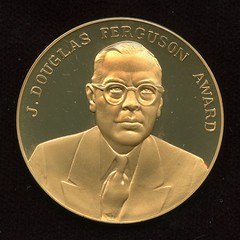

Ferguson Medal. Regitko was awarded the Ferguson Medal in 1991, being the highest Canadian numismatic distinction award. It is gold-plated silver and in its case of issue. This is the first such award we have had the pleasure of offering.
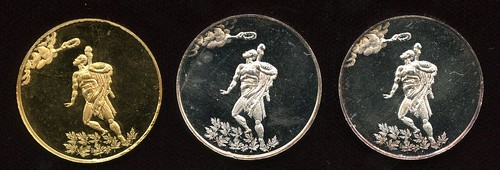
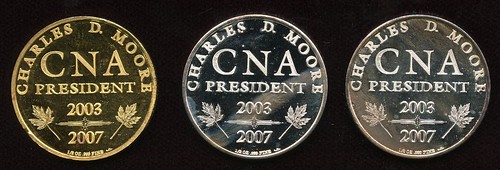
202 pieces were struck by the Lasqueti Mint of Lasqueti Island, BC on half-ounce .999 silver blanks. They were distributed by Charles Moore in the registration kits of the 2007 CNA Convention; a second silver piece was struck by re-worked dies, as is evident in the clouds, arm and hand above Hercules; of the three half-ounce gold pieces ordered by Moore which were struck by dies with additional rework, two are in the possession of Moore's two children, making the gold piece in this lot the only one available to collectors of CNA/RCNA memorabilia. Not only is the gold piece the only one available to collectors, but each of the three medals was struck by reworked dies, believed to by the only set with both of the silver pieces due to controlled distribution of the medals in the registration kits. 3 Pcs.
To read the earlier E-Sylum article, see:
NOTES FROM E-SYLUM READERS: MAY 6, 2018 : On Disposing of Hobby Award Medals
(http://cbt.coinbooks.org/v21/esylum_v21n18a17.html)

THE CEYLON TOKEN OF A.E. SCHMIDT CO.
Kavan Ratnatunga of Sri Lanka writes:The A. E. Schmidt Co, St Louis Mo even appears on a Ceylon Mn token.
Thanks. Here's the first token we discussed with the A. E. Schmidt and Co mark, followed by the aluminum Ceylon, Minnesota piece and commentary from Kavan's web site. -Editor
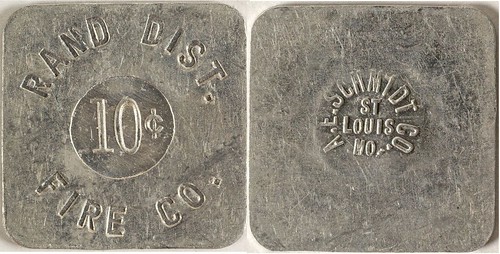
Randsburg District Fire Co. Kern County, CA
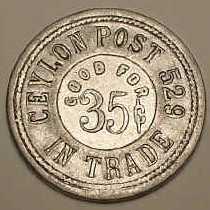
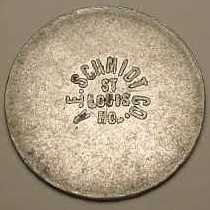
CEYLON POST 529 token, Ceylon, MN
Obverse: Good For around 35¢ at center with CEYLON POST 529 above and IN TRADE below incuse along the periphery.
Reverse: A.E.SCHMIDT & CO around ST LOUIS MO. in 3-lines relief at center.
A.E.Schmidt & Co. is the token maker from St. Louis, Missouri.
The Ernest G. Nassen Legion Post organized in 1920. They built the pavilion for their legion meeting hall. and later turned it over to the to the village of Ceylon.
1966 October 29, Shelton Gunaratne, on a World Press Institute fellowship at Macalester College, St. Paul had a friend from the Twin Cities bring him to Ceylon. He had discovered that his native island of Ceylon had a namesake in Minnesota. He met MN Senator Walter F. Mondale at Worthington's Turkey Days this fall. Gunaratne said of that meeting: When I told Senator Mondale that I was born in Ceylon, Senator Mondale said he was born in Ceylon, and soon discovered we were talking about two different places.
When I saw the first token I didn't realize "St. Louis" was the location of the token maker, not the issuer. And this one reminds us that the place of issue can be ambiguous as well and may require some research to pin down. After all, local tokens were meant for local use, and everyone encountering them at the time knew exactly what was meant. Decades later in numismatic circles, not so much. -Editor
To read the complete page on Kavan's web site, see:
USA 1960's - Ceylon MN Post #529 (http://coins.lakdiva.org/ceylonmn/post529_ceylon_mn_35c.html)
To read the earlier E-Sylum articles, see:
SELECTIONS FROM THE HOLABIRD 2018 NCTA SALE : Lot 167: Randsburg District Fire Co. Token
(http://www.coinbooks.org/v21/esylum_v21n34a17.html)
NOTES FROM E-SYLUM READERS: SEPTEMBER 2, 2018 : Notes on Tokens
(http://www.coinbooks.org/v21/esylum_v21n35a09.html)
THE BOOK BAZARRE
HARVEY STACK ON THE 50 STATE QUARTER SERIES
In the 1990s Harvey Stack was concerned about the waning interest in U.S. Mint products due to the overselling and overhyping of commemorative issues which caused many hopeful buyers to lose money on their purchases. He thought we needed a commemorative coin program that everyone could afford, and wanted to promote the idea of circulating commemoratives. Here's his account of how the 50 State Quarters program came about. -Editor
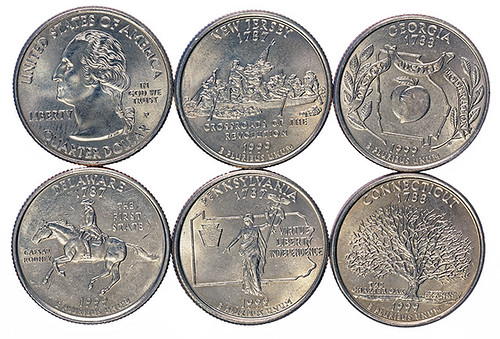
I personally approached Representative Jimmy Hayes, who was a client and close friend of ours. He was aware of the plight created by the Mint, for not only did he hear it from dealers like myself, but collectors he met or knew at conventions.
Jimmy remarked that "you professionals need to tell Congress about this. It is hard for me to do it directly, but since I know and have worked with Michael Castle, the representative from Delaware who is currently head of the House Finance and Banking Committee, I think I can ask Michael to convene a hearing, invite professionals like yourself to testify and see if there may be a way to resolve this problem.
Well, it happened. Michael Castle convened a House Meeting, invited some dealers including myself, as well as representatives from some Numismatic Museums, author David Ganz, and of course the then Director of the Mint Philip Deihl to testify.
A few went before me at the hearing, mostly trying to outline the history of coins, how and why some were issued and it was a good background about the hobby. When I was asked to speak I went through explaining (which is in the Congressional Record of the Hearing) the abuses and losses that the public had sustained by the basic "profiteering" by the Mint.
When Philip Deihl testified he talked of the costs the Mint sustained in designing and promoting the coins, and since all legislation that authorized the special commemorative issues, did reflect that the cost could be considered in the price to recover the expense, and some arbitrary profit could be added on. That is what he told the Committee.
Michael Castle was a warm hearted Congressman, called for a break for lunch and to return that afternoon to finish all the testimonies. When we reconvened, Michael Castle as Chairman, led the question period to get more information.
Again, those who went before me, though great academic scholars, had only basic academic suggestions.
Then came my turn. Representative Castle looked down from high desk that the committee sat at and asked me, "Mr, Stack, you are here as a professional Numismatist, who has to deal with the public on a daily basis - HOW WOULD YOU SUGGEST A RESOLUTION TO THIS PROBLEM ?"
I stood up, and first suggested that not everyone collects for the idea of "preserving capital" or making "an investment". Many collectors do so for the "pride of possession." Many started out trying to find out how many different dates and mints they could find in their daily change. Many collected as a plain hobby and fun.
Then I continued. "If many look at their change for the "seek and find" games they do themselves, or maybe some members of their family do the same, and they encourage them to "look and you may find" then maybe the idea I have nurtured might be one of the answers to the questions you and other committee members asked."
I said, "we have an opportunity to teach our young folks as well as seniors that collecting coins might be educational and instructive, and broaden the information that our money can give them. In 1976 Congress authorized a Commemorative Quarter, commemorating our Bicentennial year as a nation. The quarter was readily found in the daily change about the country, and reminded many that we have existed for two full centuries. It was a patriotic reminder. And from the educational side, it alerted many of a fact they might have forgotten. It was a great idea of Congress!"
I then continued, "what do you think of continuing the quarter as the messenger about all of the states in the union? How about, in as many years that your committee and the mint think it is practical, strike a quarter that will show on it the name of the state, maybe its capital and in the design either some product they are known for, or some statue or building, show the date Of when each joined the union, starting of course with those that first signed our constitution, and therefore Be an excellent reminder of our history and also a piece of money that could either be spent, or saved for others to learn from?
All the members of the committee seemed to smile at the idea, each thought of commemorating their OWN state, and how well it would be received by their constituents.
As I was about to sit down, Mike Castle, with a twinkle in his eye, and what seemed to be a great inflation of his chest, said to me, "Mr. Stack, I think that your idea is a great one, as do most of my committee up here with me, AND PLEASE REMEMBER, SIR, THAT THE STATE OF DELAWARE WAS THE FIRST TO SIGN THE ARTICLES OF CONFEDERATION, and as your plan suggested, the State of Delaware will be the FIRST DESIGN AND ISSUE for a STATEHOOD QUARTER HONORING ALL THE STATES IN THE UNION."
The others who testified expressed their endorsement of the concept, and David Ganz then expressed his favorable Law Opinion of the idea, and even Director Diehl, realized that the idea was one that could help revive public interest in the history of America, and be a great teacher of some basic facts about our wonderful Union.
The rest is history. Starting in 1999 we issued a CIRCULATING QUARTER AT FACE VALUE, and so until we commemorated all our 50 States and possessions.
I wrote this once more, to try to help those who do not know how the STATEHOOD QUARTER WAS BORN, and try to explain, when you offer the public some idea that is different you can be successful in trying to expand the hobby. That is what I learned as a youngster, from my father and uncle who trained me that to collect, one must have a desire to have and hold what they save, and encourage others to collect, like our numismatic forefathers did.
To me, today's professionals need to try to further understand what can make a collector, and nourish that idea when you serve them.
Thanks, Harvey! It was a great program, and opened a great number of eyes to the joys of collecting coins. -Editor
To read the earlier E-Sylum article, see:
THE 50 STATE QUARTERS PROGRAM (http://www.coinbooks.org/v21/esylum_v21n35a21.html)

IS NUMISMATIC INTEREST GROWING?
A September 6, 2018 Numismatic News article by Pat Heller ponders changes in the hobby over the last 50 years, and notes several signs of increased interest in numismatics. -Editor
 So, is numismatic interest growing or not? The answer seems to be – it depends.
So, is numismatic interest growing or not? The answer seems to be – it depends.
I have worked in a retail coin store for the past 37 years. It is located in a metropolitan area with a population of about one-third of a million. There has been a definite decline in the number of young numismatists and even adult collectors who stop by to shop with some regularity. We also have lower retail sales at coin shows than occurred in past decades. Some of this is offset, at least partly, by the increase in online demand in sales by our own company, where there were none back in the 1980s. Just looking at these changes, you might be quite worried that the hobby of numismatics is losing ground the same way that has happened with philately, also known as stamp collecting.
Supporting this pessimism, the average age of members of the American Numismatic Association has, unfortunately, increased almost 10 years over the past decade or so at the same time that its membership has dwindled.
But there is reason to hope that numismatics may be gaining collectors in different ways.
In a recent interview in The MichMatist, the magazine of the Michigan State Numismatic Society, Jim Stoutjesdyk, Vice President of Numismatics for Heritage Auctions in Dallas, Texas, points out this his company’s auction at this past January’s Florida United Numismatists show received bids from more than 8,000 people even though only a few hundred personally attended the sales. He is amazed how many six- and seven-figure coins his company can place with new owners who have not personally examined the acquisitions ahead of the auctions.
I sometimes visit local coin shops when I attend coin shows around the country. In years past, it was often an opportunity to acquire some goodies for which the dealer didn’t have a local outlet. But in the past year, I have heard multiple times from dealer friends that they don’t really have anything to sell me because “all the good stuff I get now goes for sale online.” Obviously, someone else is buying these coins and currency.
I am definitely in the "glass half full" cadre - from everything I see and hear, a new generation of buyers is out there in the market, even if we're not seeing them in person at shows and club meetings. -Editor
To read the complete article, see:
World shows new interest in coins
(http://www.numismaticnews.net/article/world-shows-new-interest-in-coins)
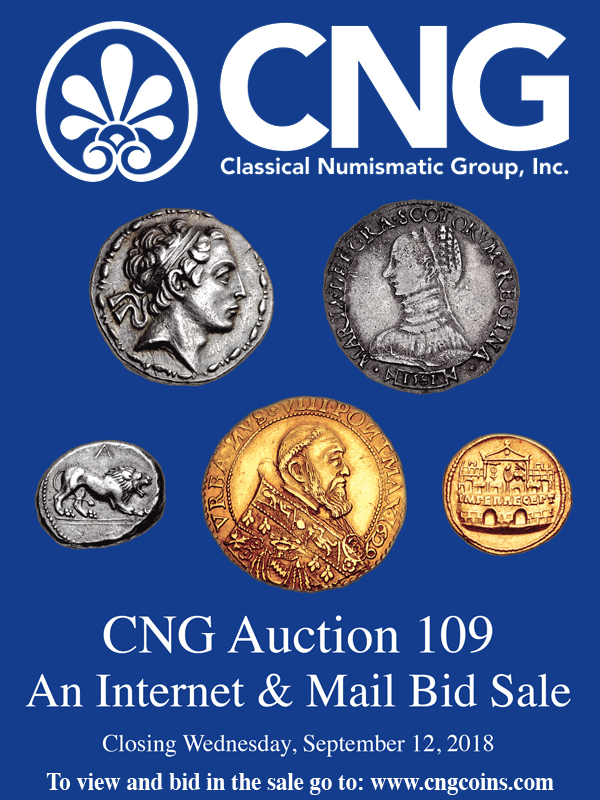
VOCABULARY ANNIVERSARY: 100 WEEKS
Dick Johnson submitted this note about his regular weekly numismatic vocabulary articles. Thanks! -Editor
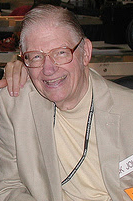 For nearly two years I have highlighted one or more vocabulary terms each week; 128 terms have appeared in the last 100 weeks. These have been adapted from my
Encyclopedia of Coin and Medal Technology. The importance of having an understanding of the special terms, the language of the field cannot be over stated. Everyone in the
field should have the same understanding of an unusual word or term for clear communication.
For nearly two years I have highlighted one or more vocabulary terms each week; 128 terms have appeared in the last 100 weeks. These have been adapted from my
Encyclopedia of Coin and Medal Technology. The importance of having an understanding of the special terms, the language of the field cannot be over stated. Everyone in the
field should have the same understanding of an unusual word or term for clear communication.
In addition to the definition of the term in the first sentence most of the entries have a further explanation. These, in effect, are encyclopedic entries revealing the full meaning, use and history of the term in the numismatic field. The use of the term in cataloging numismatic specimens is often mentioned – one of the vital facets of the field.
So important is this reference work that I elected, with the gracious permission of the Newman Numismatic Educational Foundation, to place this Encyclopedia on the internet. Every term may be accessed without cost on the Newman Portal under Dictionary.
Thanks, Dick! I always look forward to Dick's vocabulary submission each week. Always something new and interesting to learn. -Editor
To acces the Newman Numismatic Portal numismatic dictionary, see:
https://nnp.wustl.edu/library/dictionary
VOCABULARY TERMS: PEDIGREE, PROVENANCE
Dick Johnson submitted these entries from his Encyclopedia of Coin and Medal Terminology. Thanks! -Editor
Pedigree. The record of previous owners of a valuable item. An item said to be “pedigreed” is one whose prior ownership is known, often a famous
collector. Records of auction sales are the most useful in identifying a numismatic items’ pedigree. A term with similar meaning is PROVENANCE (q.v.).
CLASS 11.4
Provenance. A pedigree; the record of previous ownership of an artifact or numismatic item. A provenance is important only for the most valuable or rarest items and is highly regarded when an appraisal is made on the item. A search of auction catalogs, sales literature, trade publications and such is required to compile such a pedigree or provenance. When this information is found the item is said to be TRACEABLE.
Private treaty sales without publication of such transactions often provide stumbling blocks to compiling such prior list of owners, but research is conducted to learn who owned it, when each purchase or transaction was made, and how much was paid at each sale, a PRICE STUDY. When histories of rare items are written, provenance often plays an important role, as in the case of the book on the 14 known 1804 U.S. silver dollars by Eric P. Newman and Kenneth Bressett. The documented knowledge that a famous collector once owned an item adds greatly to its charm (and often its auction price!).
Note: this term is spelled correctly above and is not the “provenience” – which also means origin – that will appear on computer spellcheckers.
CLASS 11.4
Reference: {1962} Newman and Bressett.
Looking for the meaning of a numismatic word, or the description of a term? Try the Newman Numismatic Portal's Numismatic Dictionary at: https://nnp.wustl.edu/library/dictionary
Or if you would like a printed copy of the complete Encyclopedia, it is available. There are 1,854 terms, on 678 pages, in The Encyclopedia of Coin and Medal Technology. Even running two a week would require more than 19 years to publish them all. If you would like an advance draft of this vital reference work it may be obtained from the author for your check of $50 sent postpaid. Dick Johnson, 139 Thompson Drive, Torrington, CT 06790.
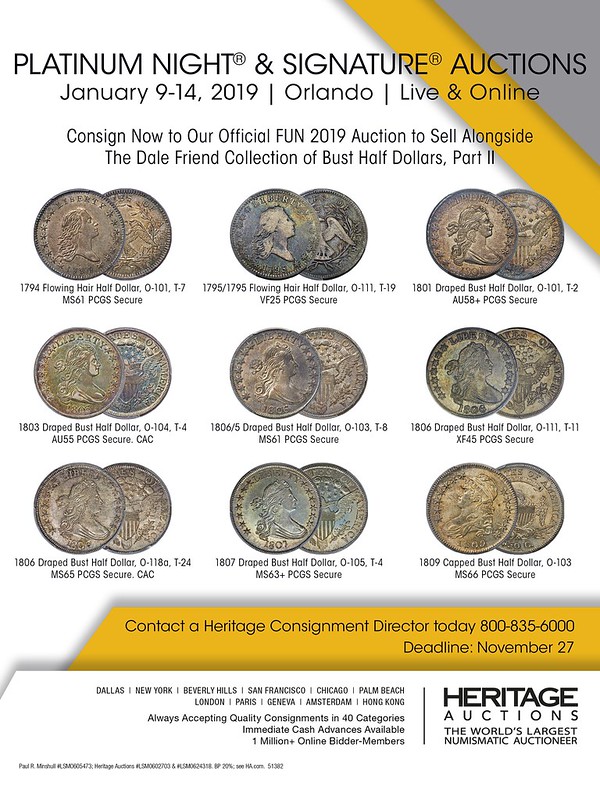
HENRY DAVENPORT (1811-1898)
Henry Davenport (1811-1898), was born on November 18, 1811, at Boston, Suffolk County, Massachusetts, son of Elijah Davenport (1773-1844), a prominent merchant, and Susan Ward Davenport (1781-1851). He was a direct descendant of Thomas Davenport of Dorchester who lived there in 1640. The Isaac Davenport House, Green Street, Dorchester is a historical site.
Davenport was one of the best-known mercantile men and mill owners in New England.
He most probably began collecting coins and tokens no later than the 1830's. He is also most probably the same person described by Lyman H. Low as Captain Davenport as Lindesmith suggested in 1967, who, in 1837, acquired the 1785 Copper Confederatio (PCGS AU53 BN). That coin was subsequently acquired by J. N. T. Levick in 1864.
On June 14, 1843, he married Caroline Howe (1823-1911). They had three children : Annie Ward Davenport [Cleveland] (1850-1922), George Howe Davenport (1852-1932), and Francis Howe Davenport (1851-).
He was an officer in the Pacific Mills company from 1854-1891.
He was a buyer at the Henry Bogert sale at Bangs, Merwin & Co., New York, held on February 28, 1859.
On February 11, 1860, Dr. Winslow Lewis, Jeremiah Colburn, Judge John Phelps Putnam, and William Sumner Appleton incorporated the Boston Numismatic Society. In 1865, Davenport served as Treasurer, and later on Curator, and was also elected Vice-President. He was known to have owned one of the finest coin collections in New England.
In 1862, he was appointed by President Abraham Lincoln, as a member of the Committee of Examination of Coinage at the U. S. Mint, Philadelphia.
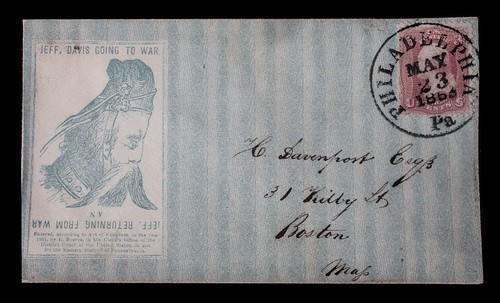
Edward Cogan to Henry Davenport postmarked May 23, 1863, Philadelphia.

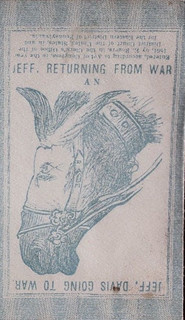
Cover inverted shows the portrait of Jeff Davis transformed into an Ass.
Davenport and J. N. T. Levick are known for having token restrikes made by the Scovil Manufacturing Company, of Waterbury, Connecticut, and Hard Times tokens engraved by Edward Hulseman.
In 1871, at a monthly meeting of the Boston Numismatic Society he exhibited his 1787 Massachusetts Cent.
He died suddenly of heart disease at the home of his son-in-law, Dr. Clement Cleveland on January 24, 1898, at New York. He is buried at Forest Hill Cemetery and Crematory, Jamaica Plain, Suffolk County, Massachusetts.
To read the complete article, see:
DAVENPORT, HENRY
(https://sites.google.com/a/numismaticmall.com/www/numismaticmall-com/davenport-henry)
The entire inventory of the Lupia Numismatic Library is for sale. Individual items will be available before the remaining archives are broken up into parcels sold at philatelic auctions in the U. S. and Hong Kong. Check NumismaticMall.com frequently as dozens of new items with estimates will be posted daily until everything is sold.
All inquiries will be given prompt and courteous attention. Write to: john@numismaticmall.com .
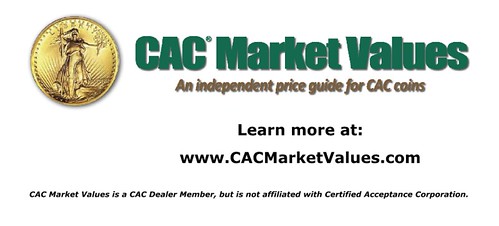
HARVEY STACK'S NUMISMATIC FAMILY, PART 26
Harvey Stack's blog series focuses on growing up in a numismatic family. Here's part 26. Nothing beats a report on numismatic events and personalities direct from someone who was there to witness them in person. Thanks, Harvey! -Editor
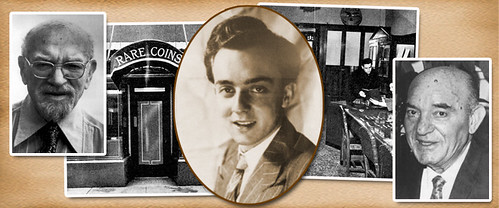
The year of 1958 continued the growth of the numismatic hobby, and many new collectors entered the field. Stories appeared in various newspapers and magazines about numismatics. These included reports of coins found in diggings in the ancient world, of the value and growth of collecting, stories about old time collections being sold and how the sellers had realized increases in value. It was reported that coin collecting was the “hobby of kings,” including tales of the Farouk Collection that had been sold in 1954. There were descriptions of major collections, including stories about Louis E. Eliasberg and his “most complete collection of United States coins ever assembled.” The focus on the history, romance, and financial potential of coins all helped to increase interest in numismatics.?
Stack’s retail business continued to grow, as new collectors entered the field. There was enthusiasm to complete short sets, such as two-cent pieces, nickel three-cent pieces, Shield, Liberty Head and Jefferson nickels, Roosevelt dimes, twenty-cent pieces, Washington quarters, Franklin half dollars, Peace dollars, Indian quarter eagles and type sets of commemoratives – both gold and silver. The supply of the "short sets" was helped by the number of rolls put away in the early years, as well as the limited number of coins needed for completion (thus the name – short sets). These were a good way to start a collection as these coins were relatively available and also relatively low in cost. These short sets also provided a feeling of completion to a beginning collector. They then could return to the market to build a new collection.
Some collectors bought such sets already complete from dealers; others built them one coin at a time, searching for the quality they desired, or even the toning they preferred. Dealers broke up the sets they acquired to meet various clients’ needs. Interest spread and the market developed.
We had sold many gold coins to collectors who developed an interest after World War II. We were able to place coins from collections we had purchased earlier, such from the Col. E.H.R. Green Collection we acquired in the 1940s. In this way gold coins also made their way from the collections of the past to new homes with contemporary collectors.
In addition, our public auction sales also brought back to market coins that had been held in old-time collections. Among these sales were the Crosby-Mayfield Collection, the John Wharton Collection, the 1958 N.Y. Numismatic Sale, the Smith Ely Goldsmith Collection (an extensive holding of dimes and early Proof sets from 1858 to 1915), and a general collection formed by Frank Chase. Our sales were well attended, with hundreds of collectors filling the auction sales room, "standing room only" in many cases, along with record numbers of mail bids adding to the demand.
The many counterfeits entering the country and being sold as genuine continued to be a major problem. The U.S. Secret Service traveled from one dealership to another picking up the false coins they found, and in some cases indicting the dealer for selling "false coins." Along with other professional dealers, we were called upon to help the agents determine "good from bad" so they could do their job efficiently. This was just one more part of our mission to serve collectors and the hobby.
To read the complete article, see:
Harvey Stack Remembers: Growing up in a Numismatic Family, Part 26
(http://www.stacksbowers.com/News/Pages/Blogs.aspx?ArticleID=3098)
To read the earlier E-Sylum article, see:
HARVEY STACK'S NUMISMATIC FAMILY, PARTS 23-25 (http://www.coinbooks.org/v21/esylum_v21n34a15.html)

PATRICK RICHEY JOINS WORLD NUMISMATICS, LLC
World Numismatics of Carefeee, AZ issued this press release welcoming Patrick Richey to their staff. -Editor
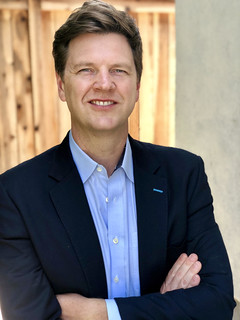 World Numismatics LLC is proud to announce that Patrick Richey has joined our team as a full-time numismatist and will be a key component in expanding the company. Mr.
Richey is well versed in both ancient and modern coinage with a focus on 1st Century Roman Gold and U.S. Gold. He has successfully worked in the numismatic field for over 15 years
as a trader and consultant and has assisted numerous collec- tors and wholesale clients in acquiring iconic rarities for theirn collections.
World Numismatics LLC is proud to announce that Patrick Richey has joined our team as a full-time numismatist and will be a key component in expanding the company. Mr.
Richey is well versed in both ancient and modern coinage with a focus on 1st Century Roman Gold and U.S. Gold. He has successfully worked in the numismatic field for over 15 years
as a trader and consultant and has assisted numerous collec- tors and wholesale clients in acquiring iconic rarities for theirn collections.
Mr. Richey comes to us with an M.A. in Ethnomusicology (2008, University of California, Santa Cruz) and a B.A. in Music Performance (2000, University of Kentucky). In addition to his musical talents, he is fluent in English, Spanish and Hindi.
Prior to joining World Numismatics LLC, he was most recently employed by Minshull Trading (2014-18) to grow the firm’s world and ancient offerings after working for Bellevue Rare Coins (2010-12). He is an ANA member and attends most of the major U.S. and international coin events.
As a researcher of various world musical traditions, Patrick has traveled throughout India, Morocco, Europe and Asia. He has also performed in variety of venues including UCLA’s Royce Hall, Mohamed V Theater in Rabat, and at UNESCO in Paris. These experiences have helped him to appreciate collector coinage under a unique perspective for their historical and cultural value.
Patrick aims to expand both World Numismatics LLC’s distribution network and outreach to vendors worldwide. He is excited to continue to expose the wonder of world and ancient coins to U.S. collectors and dealers and is encouraged by the coin market’s renewed interest in historic coinage and the value these items have in our world as relics and great stores of value.
To visit the firm's web site, see:
https://worldnumismatics.com/

THE NUMISMATIC MUSEUM OF ICELAND
On July 28, 2018 Tom Babinszki published an article on his Blind Coin Collector blog about his recent visit to the Numismatic Museum of Iceland. With permission, here's a lengthy excerpt. -Editor
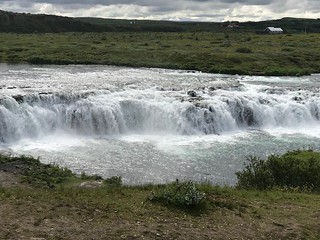 It was a very unusual start for a trip. In a long time, the first time I wasn’t traveling for business. Just recently they introduced a daily flight from Cleveland
to Reykjavik. At home we have talked about it, soon after which My daughter, Emily brought home a book from the library about Iceland, and a few days later she started telling
people that I’m taking her to Iceland. I had no idea where she got the idea from, but we talked about it with my wife, and it sounded like the perfect vacation idea. As
always, I checked if there was a money museum there, and sure enough, there was one.
It was a very unusual start for a trip. In a long time, the first time I wasn’t traveling for business. Just recently they introduced a daily flight from Cleveland
to Reykjavik. At home we have talked about it, soon after which My daughter, Emily brought home a book from the library about Iceland, and a few days later she started telling
people that I’m taking her to Iceland. I had no idea where she got the idea from, but we talked about it with my wife, and it sounded like the perfect vacation idea. As
always, I checked if there was a money museum there, and sure enough, there was one.
A few weeks before we left for Iceland, I sent an email to the Numismatic Museum, which is part of the Icelandic National Museum. In a couple of days I got a response that our family is welcome to attend a tour at the Museum at the time of our choosing. This was very generous, especially because we found out that the museum’s curator, Mr. Sigurður Pálmason came in to meet us during his vacation.
I am ashamed to admit, though originally I planned to, I did not learn much more than yes and no in Icelandic. However, it was also interesting to find that there was no time when I needed Icelandic. As soon as people figured out that we weren’t local, and probably it wasn’t a difficult guess, they switched to fluent English, and it was very easy to communicate. Mr. Pálmason for example apologized for his English, but I don’t think it was any worse than mine after living in the US for many years. And in general it wasn’t anything unusual. It was nice to hear the language though on the streets in real life, it gave me a better idea of what it really sounds like.
It fascinated me how this little country can provide all the necessary knowledge people need. Just for a comparison, a little more than 300 thousand people live in the country, a bit more than half of the people in Cleveland. Outside of the country, not many people speak Icelandic, yet, they have everything a large country has. Schools, at least one university I know of, parliament, stores, banks, entertainers, authors, translators, radio operators, DJs, news broadcasters, and of course, many tour guides.
We visited the museum on the third day of our stay, hoping to give the kids a couple of days to adjust to the time difference. Asking to learn about local coins was the best idea. The museum has some 5000 artifacts, but what we have learned about the money of Iceland I couldn’t have found anywhere.
Before the trip, I tried to find some information, I mostly read related articles on Wikipedia and in the Krause Catalog. I did find a list of coins and most notes, but it was nothing more than a list. I have to say, it didn’t even sound interesting, and I was a bit worried what is there in Iceland, as they only introduced coins in 1922. Before that, they used Danish coins according to the resources I found, but we learned from Mr. Pálmason that it was more than that, they had all kinds of different Scandinavian coins, the museum even has a Swedish plate money.
Iceland started to use its own currency earlier, in 1886 they started issuing bank notes, this is when “Iceland” started appearing on currency, so when the first coins came out the Icelandic Krona already existed.
Iceland had three sets of coins, but interestingly after 1944 when they declared independence from Denmark, they did not issue new coins due to the shortage of metal after World War II, so the old coins with the crown were used until the 1970’s, when new coins were issued.
In 1980, a new set of coins became necessary when the Icelandic Kronur was devalued after a heavy inflation. A new inflation hit the currency after 2008, but it wasn’t as big as the previous one.
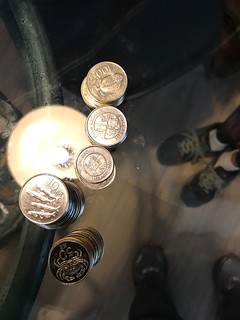 I had a chance to touch all the coins used in circulation before the current sett. I did get the current coins from the stores before we visited the museum. Needless to
say it was the first thing I did. Since I didn’t have too many coins from Iceland, and even those have doubles, the current set of coins were new to me. There are some very
nice, large, easy to identify coins. Not only the designs are easy to tell apart, but the edges and sizes are also very distinct.
I had a chance to touch all the coins used in circulation before the current sett. I did get the current coins from the stores before we visited the museum. Needless to
say it was the first thing I did. Since I didn’t have too many coins from Iceland, and even those have doubles, the current set of coins were new to me. There are some very
nice, large, easy to identify coins. Not only the designs are easy to tell apart, but the edges and sizes are also very distinct.
After an overview of the Icelandic coinage, we also got an introduction to the bank notes. We found out that all kinds of different notes were used, three entities officially issued bank notes, the largest being the Bank of Iceland, which was a private entity. Notes came in all colors. People at the bank signed each note individually. The largest bank note originally was a 50 Kronur, which was worth many months of salary at the time. Thus, very few survived, because people used them. There is only one note in private collections, in the bidding war on an auction the price went up so high that some people decided to buy it together to split the costs, and each one of them now holds the note for one year and passes it on.
After the overview of the currency of Iceland, we found out that Mr. Pálmason is working on a project to digitalize the holdings of the museum to make it available online. I am happy to find that more and more museums take this approach. Consequently, if done well, much more information will be available to blind people this way.
It was a fascinating visit. I did not detail here all we have learned, but Mr. Pálmason gave us a very interesting and detailed introduction to the currency of Iceland, the museum is absolutely worth visiting, and we haven’t even seen the majority of the objects. But I am convinced again, that the best way to go is to ask local people about local coins, which they value and understand thoroughly.
Another museum which I would highly recommend to anybody.
To read the complete article, see:
Visiting the Numismatic Museum of Iceland
(http://blindcoincollector.com/2018/07/28/visiting-the-numismatic-museum-of-iceland/)
BRAZIL'S NATIONAL MUSEUM BURNS
Regarding the fire at Brazil's National Museum, Arthur Shippee writes:
One imagines some significant numismatic loss.
As a natural history museum, I wouldn't expect it to have held numismatic content, but anything is possible. So far I have not heard of any numismatic losses. Here's an excerpt from an ArtDaily article. -Editor
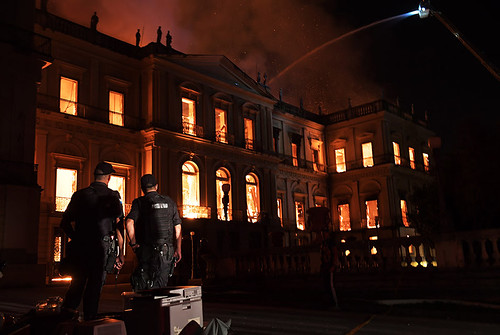
A massive fire ripped through Rio de Janeiro's treasured National Museum, one of Brazil's oldest, in what the nation's president says is a "tragic" loss of knowledge and heritage.
The majestic edifice -- which was closed to the public when the fire started -- was swept by flames as plumes of smoke shot into the night sky, while scores of firefighters battled to control the blaze.
Five hours later they had managed to smother much of the inferno that had torn through hundreds of rooms, but were still working to extinguish it completely, according to an AFP photographer at the scene.
The natural history and anthropology museum -- founded in 1818 and home to over 20 million valuable pieces -- has suffered from funding cuts, forcing it to close some of its spaces to the public.
The head of finance and planning at the Federal University of Rio de Janeiro, on which the museum depends, described the destruction as "a loss to the whole world."
To read the complete article, see:
Raging fire tears through Rio de Janeiro's
treasured National Museum (http://artdaily.com/news/107319/Raging-fire-tears-through-Rio-de-Janeiro-s-treasured-National-Museum#.W5MaoehKiAs)
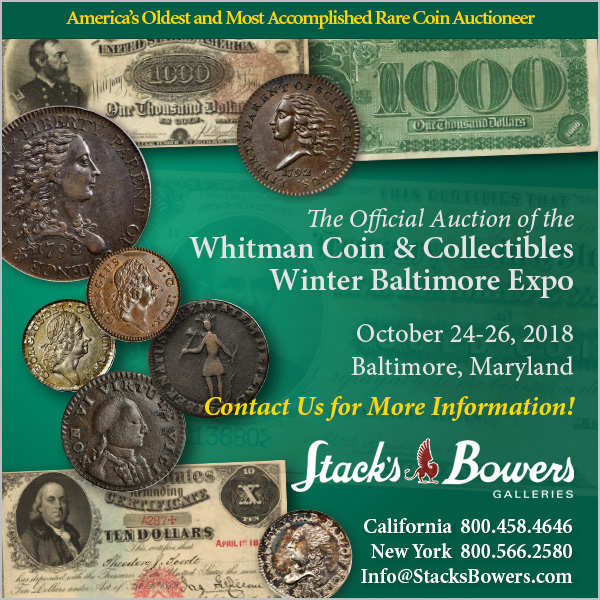
PAN 2018 FALL COIN SHOW SCHEDULE
Pat McBride of the Pennsylvania Association of Numismatists provided this information about the fall coin show they're hosting this week. I'll be there giving a presentation on the Newman Numismatic Portal, and hope to see many of our readers there.
The PAN show is always vibrant - the deep collector base in Western Pennsylvania comes out in force, as seen in the below photo from an earlier show. It's a short drive from multiple states, and I encourage anyone who hasn't been there before to check it out. -Editor
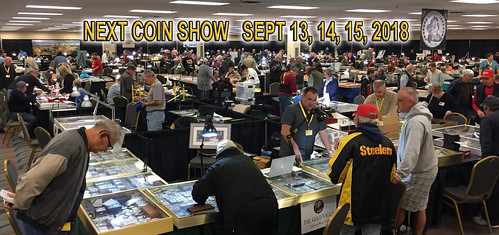
The Pennsylvania Association of Numismatists (P.A.N.) Fall Coin Show & Convention is a full experience into the world of numismatics. It is held at the Monroeville Convention Center, near Pittsburgh, PA. There are 150 tables with 100 national and local coin dealers to buy, sell, and trade all numismatic items. A $1 optional door donation enters you in a drawing for a one tenth ounce American Gold Eagle coin.
The PAN Lecture Series that is presented by knowledgeable speakers of various numismatic topics. Featured speaker at this coin show will be Mr. Bob Evans, Chief Scientist and Historian of the S.S. Central America project, and the co-discoverer of the shipwreck site. This shipwreck of 1857 is considered one of the largest gold discoveries ever located with an estimated value of $200 million of gold coins and bullion. His presentation is scheduled for Friday, September 14 th .
Lecture Schedule Friday September 14 th
12:00 pm Ron Shintaku, Large Cent Specialist, EAC, ANA, PAN
Topic: “1793 U.S. Copper Coinage: Historic, Scarce and Desirable”
1:00 pm Mark Benvenuto, Published Author in many numismatic Journals
Topic: “U.S. Silver and Gold, Good Grades and Good Prices”
2:00 pm Wayne Homren, Editor of The E-Sylum, electronic newsletter
Topic: “Pittsburgh Banking History and the Newman Numismatic Portal”
3:00 pm John Frost, President of the Barber Coin Collectors’ Society
Topic: “Fascinating New Discoveries regarding Father-Son Mint Engravers William and Charles Barber ”
4:00 pm Bob Evans, Chief Scientist and Historian of the S.S. Central America
Topic: “The Many (and New) Treasures of the S.S. Central America: Revelations & Stories From the 2014 Recoveries”
PAN offers a very active Saturday kid’s program hosted by Robert O. Stakeley from the Heinz History Center. The PANKidZone is free and open to young people under 18 years of age. They learn about rare coins through a fun presentation, filling date folders, giveaways, and a kids auction using PAN Dollars that are earned and provided. The program is family friendly with a positive environment for learning and fun!
We have an educational area that includes competitive collector exhibits to educate the viewer of a specific topic in various numismatic categories. These exhibits are judged by ANA standards. Winners receive numismatic prizes. Free Silver Eagle drawings are held in the exhibit area during the show hours.
PAN has a section that is devoted to handouts and giveaway materials. Everyone walks away with something.
We have a numismatic reference library available to use during show hours. It is a quiet area set aside to allow the curious to browse through books that feature a wide range of numismatic subjects. It is dedicated to the memory of numismatic bookseller and PAN charter member, John Burns.
For more information contact Show Chairman Blaine Shiff c/o cybercoins.net 412-531-4100
PAN is an educational non-profit organization. Please go to our website for details and updates www.pancoins.org
Coin Show Hours:
Thursday, September 13, 12:00noon – 6:00pm
Friday September 14, 10:00am – 6:00pm
Saturday September 15, 10:00am – 4:00pm
PAN 2018 FUNDRAISING AUCTION SELECTIONS
Not every state or regional show is fortunate enough to host a major national auction. Those fees can go a long way toward supporting not just the show but the whole organization. The Pennsylvania Association of Numismatists fills the gap with a small fundraising auction hosted online by CoinZip.
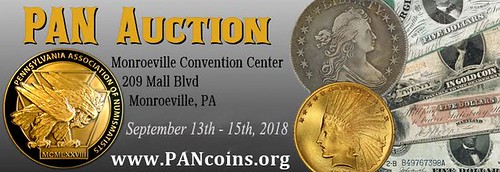
Pat McBride of PAN writes:
PAN is holding an on-line auction that is running now and will end on Friday September 14th at 5:00 pm. We have worked out an agreement with www.CoinZip.com to conduct the auction. The 10% buyers fee goes directly to PAN. There is no seller fee.
The interesting feature about this on-line auction is the ability to view the auction lots at various coin shows where PAN has a table with the final viewing at the PAN Coin Show. PAN recently had the lots displayed at the Philadelphia World’s Fair of Money. Lot pick up is Saturday September 15th for those that do not want to pay shipping.
It is a great advantage to be able to see the lots that interest you. Many times on-line auction photos cannot convey the true beauty or distractions that can influence your bid.
There are usually some interesting lots that may not come up very often. You can view the auction lots on the PAN website www.pancoins.org by clicking the PANAuctions tab or the PANAuctions icon.
Here are a few interesting lots to note. -Editor
1920 Theodore Roosevelt Founders Medal

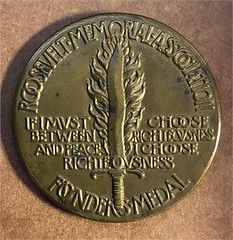
1920 Theodore Roosevelt Founders Medal
To read the complete lot description, see:
Lot 34) 1920 Theodore Roosevelt Founders Medal
(http://www.go2coinauctions.com/Listing/Details/4690078/Lot-34-1920-Theodore-Roosevelt-Founders-Medal)
German Soldier Hobo Nickel
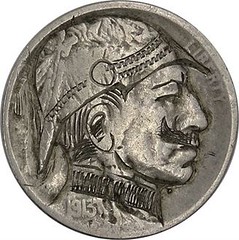
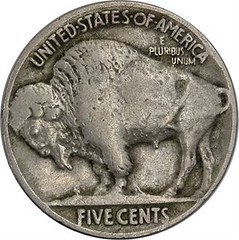
Lot 52) Vintage 1913-P Hobo Nickel German Soldier w/ Curled Moustache
The sale includes several Hobo nickel lots. -Editor
To read the complete lot description, see:
Lot 52) Vintage 1913-P Hobo Nickel German
Soldier w/ Curled Moustache (http://www.go2coinauctions.com/Listing/Details/4705021/Lot-52-Vintage-1913P-Hobo-Nickel-German-Soldier-w-Curled-Moustache)
Walter Breen Signed Check
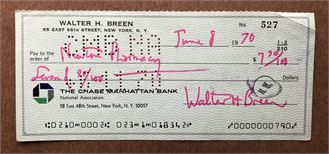
Walter Breen Signed Check
Signed in his signature purple pen. -Editor
To read the complete lot description, see:
Lot 2) Walter Breen Signed Check
(http://www.go2coinauctions.com/Listing/Details/4396636/Lot-2-Walter-Breen-Signed-Check)
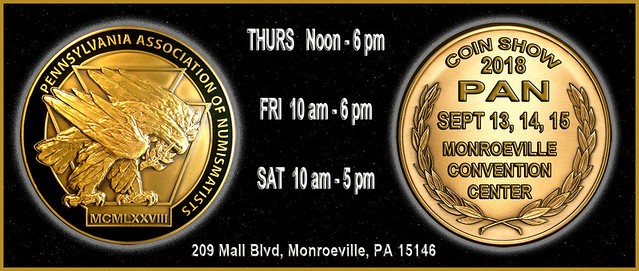
ANA 2019 SHOW DATES
It's never too soon to plan for the next big coin show. Here's a reminder from the American Numismatic Association about their 2019 shows. -Editor
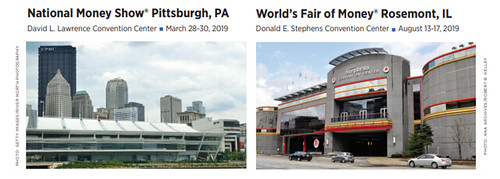
Save the Dates
Mark your calendar for the 2019 National Money Show in Pittsburgh, Pennsylvania (March 28-30), and the 2019 World's Fair of Money in Rosemont, Illinois (August 13-17). These events offer access to hundreds of dealers, spectacular exhibits, entertaining and informative educational programs, and fun family activities. Follow us on Facebook (facebook.com/numismatics) and Twitter (twitter.com/ANACoins), or visit us online at money.org.
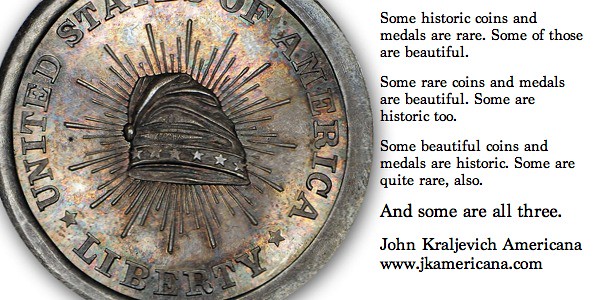
HERITAGE SEPTEMBER 2018 WORLD & ANCIENTS
Heritage cataloguers published these picks in the firm's September 6-11 Long Beach Expo World Coins & Ancient Coins Auction, published in the Heritage September 4, 2018 Coin News email newsletter. -Editor
SAM SPIEGEL'S PICKS
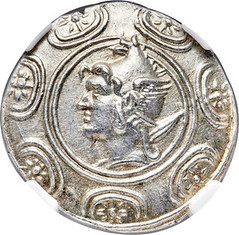
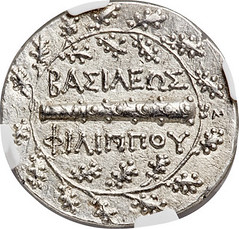
Ancients: MACEDONIAN KINGDOM. Philip V (220-179 BC). AR tetradrachm (32mm, 16.72 gm, 11h). NGC MS ★ 5/5 - 4/5 Fine Style
Though not a rare coin by any means, Philip V tetradrachms seem to have circulated widely and apparently for a long period of time, as they are usually seen today in fairly worn condition. This particular lot is exceptionally unusual in this regard, as it is not only completely uncirculated, but also free of any significant imperfections. It is truly deserving of the star designation assigned to it by NGC, and I think it would make a great addition to any high-grade ancient Greek type collection.
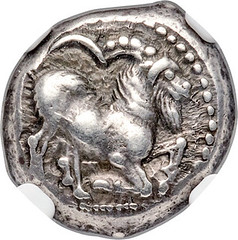
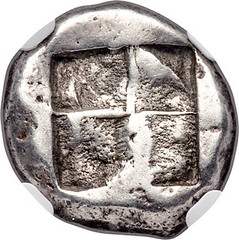
Ancients: CYCLADIC ISLANDS. Paros. Ca. 500-480 BC. AR drachm (17mm, 6.07 gm). NGC Choice XF ★ 5/5 - 5/5
As a general rule, coins of the Cycladic Islands are much harder to find than those of contemporaneous regions in mainland Greece or Asia Minor. Though not quite as rare as the Delos didrachm that we sold in our August auction, this particular piece, from the island of Paros, is still not encountered often. In fact, this is one of only two Paros drachms that we have ever sold in our history. The toning further adds to its appeal in my eyes, clearly coming from an old collection and likely stored in a cabinet, in order to get its dark gray hues.
ROXANA USKALI'S PICKS
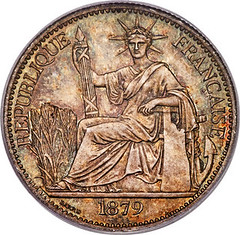
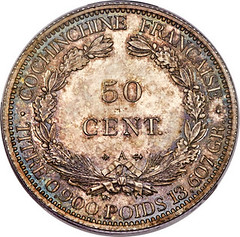
French Cochin China: French Colony Proof 50 Cents 1879-A PR66 PCGS
Right up there with the stylings of the Gothic Florin, in my opinion, is this beautifully designed French colonial issue. While not the largest denomination, nor the only French colony to bear this obverse illustration, it's definitely a scarce issue as French Cochin China existed for less than sixty years and only produced coins during ten of them. This proof emission easily wins me over with its sublime color and nearly flawless surfaces.
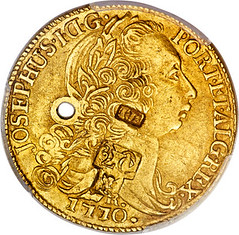
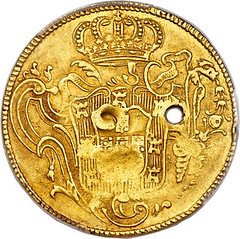
Martinique: French Colonial gold Regulated/Countermarked 20 Livres ND (c. 1805) AU53 PCGS
This coin has it all: stamps, countermarks, and a giant hole—all on an imitation flan. From yet another French colony—literally across the globe from my previous pick—this specimen hails from the Caribbean island of Martinique. What seems like an all-to-complicated way of issuing and regulating coinage, these pieces were covered with markings and assay stamps in an effort to separate genuine examples from imitations, and then pierced or plugged to regulate weight. The historical background surrounding these coins is actually fascinating, and the silver issues from this era are equally engaging.
To read the newsletter online, see:
Coin News September 4, 2018 (https://coins.ha.com/c/newsletter.zx?frame=no&id=5538#collector-c)
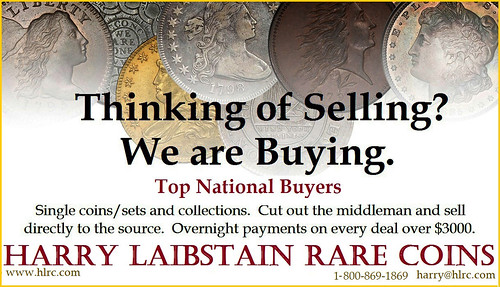
NUMISMATIC NUGGETS: SEPTEMBER 9, 2018
Here's a selection of interesting or unusual items I came across in the marketplace this week. Tell us what you think of some of these. -Editor
1588 Silver 2 Reales
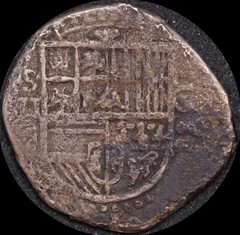
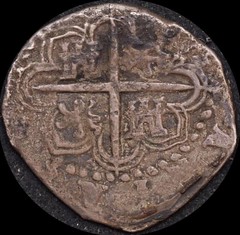
Spain 1588 Silver 2 Reales ex Gilt Dragon Shipwreck Fine
Weight: 5.82g
Mint: Seville
Quality: Fine
West Australian Museum Certificate # 2036
Just 17 of these are in private hands from this wreck.
The Gilt Dragon was a “jacht” of the Dutch East India Company (V.O.C.) that wrecked off the coast of Western Australia in 1656.
Not only was this just the 25th European vessel recorded to have reached the shores of the Australian continent, it was only the second to land with a known quantity of silver coins on board.
The Gilt Dragon stands apart from all other wrecks in Australia as being the “first modern discovery of an outward-bound seventeenth century Dutch East Indiaman.”
Found on the site of Andrew Crellin's Sterling & Currency. Great shipwreck coin. Crude pieces, but loaded with history. See the article elsewhere in this issue on coins of the Gilt Dragon. -Editor
To read the complete item description, see:
Spain 1588 Silver 2 Reales ex Gilt Dragon Shipwreck Fine
WAM Cert # 2036 (https://www.sterlingcurrency.com.au/items/spain-1588-silver-2-reales-ex-gilt-dragon-shipwreck-fine-wam-cert-2036)
1866 French Abraham Lincoln Mourning Medal

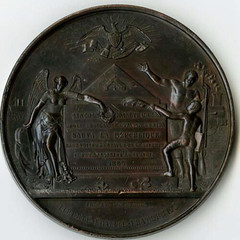
1866 French Abraham Lincoln Mourning Medal in Bronze
Rare and Impressive Round Bronze medal, circa 1866. 3.25" in circumference. Featuring a relief of Lincoln in portrait to the front. Created by Franky Magniadas. Lovely deep dark chocolate patina.
Round, bronze medallion features a profile of Lincoln in relief on the front. He wears a beard and faces the viewer's left. "Dedie par la democratie francaise a Lincoln president deux fois elu des etats-unis" is embossed around the portrait; the English translation reads, "Dedicated by the French Democracy. Twice elected President of the United States." The reverse features an image in relief depicting an altar with the following words translated to English: "Lincoln, honest man, abolished slavery, reestablished the Union and saved the Republic, without veiling the Statue of Liberty. He was assassinated the 14th of April, 1865." Below the altar are the following words translated to English: "Liberty, Equality, and Fraternity." On one side, a winged woman or Victory rests upon a sword and drapes a wreath over the altar; on the other side, two emancipated slaves, a young boy and a man, offer a palm branch and point to an eagle. A ship and train are depicted in the background. This bronze medal was struck from the original dies used to make the gold medal presented to Mary Todd Lincoln in 1866. Robert Todd Lincoln later presented her medal to the Library of Congress.
Great medal! -Editor
To read the complete item description, see:
Lot 153: 1866 French Abraham Lincoln Mourning Medal in Bronze
(https://www.invaluable.com/auction-lot/1866-french-abraham-lincoln-mourning-medal-in-bro-B964950B89)
1891 Proof Double Eagle
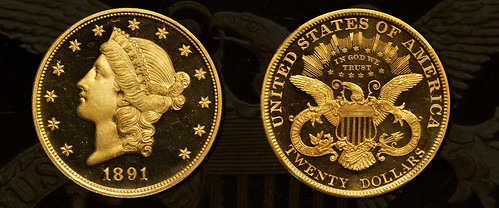
The Philadelphia Mint produced only 52 Proof double eagles in 1891 using a single pair of dies that have recently become known as JD-1 (United States Proof Coins, Volume IV: Gold, by John W. Dannreuther, 2018). As with all Proof Liberty Head double eagles, the 1891 is a major numismatic rarity at all levels of preservation. Dannreuther estimates that only 18 to 22 coins are extant, a bit higher number than those of contemporary Proof double eagle issues with similar mintages. The reason for this, in Dannreuther's words:
"The 1,390 mintage of the circulation strikes [from the Philadelphia Mint that year] makes date pressure the primary reason that more 1891 Proofs have survived than for 1890 that had an almost identical production. This is a common theme for all United States issues with low circulation strike outputs. Collectors would not spend a Proof issue if they knew that other collectors would pay a premium for their coins or they could not easily replace their Proof with a commercial strike."
Great coin. This is the first citation I noticed to John Dannreuther's great new book on proof gold. -Editor
To read the complete article, see:
October Baltimore Rarities Night - Phenomenal Proof 1891 Double Eagle Rarity
(http://www.stacksbowers.com/News/Pages/Blogs.aspx?ArticleID=3102)
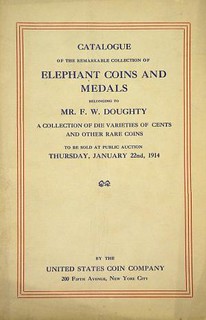 F. W. Doughty Elephant Coin Sale
F. W. Doughty Elephant Coin Sale
8vo, original printed card covers. 32 pages; 779 lots. Folded; minor discoloration. Very good or better. Adams 10. A very scarce catalogue. The sale also featured a collection of
Hard Times tokens and wide variety of large cents. Adams B-: "Elephant coins, medals. Low 1, MS Low 3, other fine Jacksons. Excelsior 1¢. Fair large cents.".
An important and scarce sale from the inventory of Kolbe & Fanning via AbeBooks. From the -Editor
To read the complete item description, see:
THE COLLECTION OF ELEPHANT COINS AND TOKENS BELONGING TO MR. F.W. DOUGHTY.
(https://www.abebooks.com/servlet/BookDetailsPL?bi=30043783148)
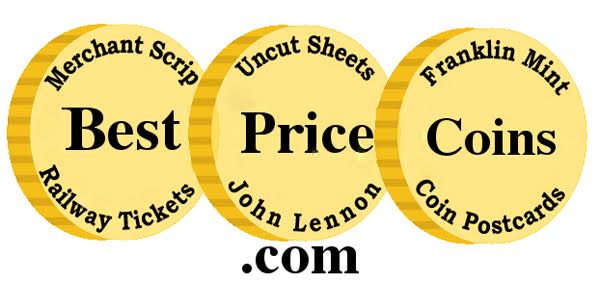
DETECTORIST FINDS ROMAN COINS NEAR ELLESMERE
A metal detectorist has found a small hoard of Roman coins on farmland near Ellesmere in north Shropshire, England. Thanks to Arthur Shippee for passing this along - it was found the Explorator newsletter. -Editor
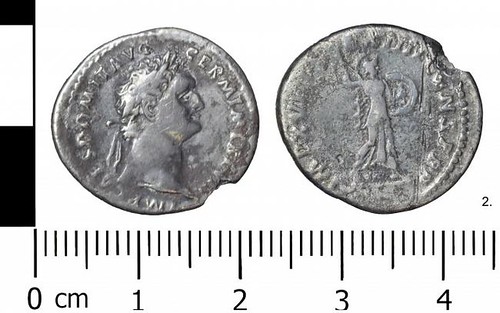
Allan Hughes, of Wrexham, found five silver Denarii coins dating back nearly 2,000 years while out searching with a metal detector on arable land in Cockshutt, near Ellesmere.
One of the coins – a Domitian-era coin from 88AD – was declared treasure by coroner John Ellery at a hearing at Shirehall.
Also among the horde were three Trajan coins dated between 103 – 111AD and a Hadrian coin fragment from 117- 133 AD.
Mr Ellery said that the coins were given to Suzie White of the North Wales Portable Antiquities Scheme and then for analysis at the British Museum.
To read the complete article, see:
Wrexham man finds finds Roman coins on farmland near Ellesmere
(http://www.leaderlive.co.uk/news/16608055.man-finds-finds-roman-coins-on-farmland-near-ellesmere/)
ROMAN COINS FOUND IN YORKSHIRE
Arthur Shippee forwarded this Guardian article (also found via the Explorator newsletter) about a Roman coin find in Yorkshire, England. Thanks. -Editor
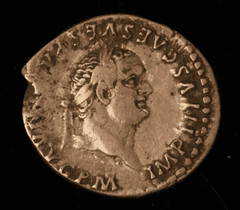 One of the earliest Roman settlements ever to be discovered in the Yorkshire region has been unearthed by a group of crowdfunded archaeologists.
One of the earliest Roman settlements ever to be discovered in the Yorkshire region has been unearthed by a group of crowdfunded archaeologists.
The first sign that there may be something worth exploring at the site came three years ago when some metal detectorists uncovered a hoard of 2,000-year-old silver coins.
Friends Paul King, Robert Hamer and Robin Siddle found the hoard of 18 silver coins in 2015, but the discovery has been kept secret until now, to enable archaeologists to explore the area, which appears to be a high-status Roman settlement.
Last week more silver coins were uncovered, with hundreds of Roman pottery sherds and a tiny brooch, found on one of three neonatal burials.
The finds so far date from the 1st century, she added: “All the coins date back to the time of the emperor Vespasian [AD 69–79], when the Romans marched north and established a centre at York.
King and his friends reported their discovery to the Portable Antiquities Scheme, which encourages the recording of archaeological objects found by members of the public. A coroner will decide ownership of the treasure.
“Archaeologists and detectorists historically have a fraught relationship. However, we were very lucky with Paul and his friends contacting the scheme and we were able to protect the site,” Wilkins said.
To read the complete article, see:
Roman coins found in Yorkshire revealed after years of
secrecy (https://www.theguardian.com/science/2018/aug/26/silver-coins-detectorists-yorkshire-reveal-early-roman-settlement)
For more information on the Explorator newsletter, see:
http://tech.groups.yahoo.com/group/Explorator/

COINS OF THE GILT DRAGON
While adding a coin to this week's Numismatic Nuggets I followed a link to this article about the coins of Dutch East India Company ship the Gilt Dragon which sank near Australia in 1656. It's by Andrew Crellin of Sterling & Currency in Fremantle, Western Australia. See the complete article online for tables of coin statistics. -Editor
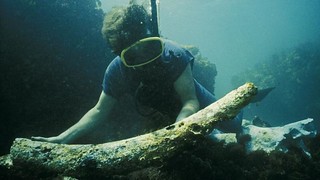 The Gilt Dragon was a “jacht” of the Dutch East India Company (V.O.C.) that wrecked off the coast of Western Australia in 1656. Not only was this just the 25th European
vessel recorded to have reached the shores of the Australian continent, it was only the second to land with a known quantity of silver coins on board.
The Gilt Dragon was a “jacht” of the Dutch East India Company (V.O.C.) that wrecked off the coast of Western Australia in 1656. Not only was this just the 25th European
vessel recorded to have reached the shores of the Australian continent, it was only the second to land with a known quantity of silver coins on board.
The Gilt Dragon stands apart from all other wrecks in Australia as being the “first modern discovery of an outward-bound seventeenth century Dutch East Indiaman.” Although the wreck of the Gilt Dragon has been studied in detail since 1963, the mystery surrounding it’s survivors remains as strong as ever.
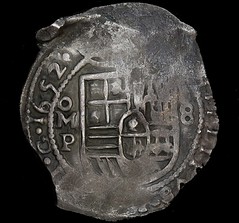 At the time the Gilt Dragon sank, it was carrying eight chests of silver coins, intended to fund the purchase of spices from Batavia (now Jakarta in Indonesia). Research
by the maritime archeologist Jeremy Green indicated that this equated to “…about 40,000 individual coins.”
At the time the Gilt Dragon sank, it was carrying eight chests of silver coins, intended to fund the purchase of spices from Batavia (now Jakarta in Indonesia). Research
by the maritime archeologist Jeremy Green indicated that this equated to “…about 40,000 individual coins.”
When the Dutch authorities in Batavia learned of the wreck, several attempts were made to secure the eight chests of treasure, however the search parties were not able to sight the wreck, let alone any of the survivors or the treasure.
The wreck of the Gilt Dragon lived on in local legend across West Australia however, yet remained undisturbed for more than three centuries, and only came to light in 1963, when several recreational spear-fishermen stumbled upon it.
The story of the period shortly following the discovery of the wreck of the Gilt Dragon is nearly as captivating as the story of the wreck itself - controversy, dynamite, bureacracy, treasure, and sadly even suicide all feature in the Gilt Dragon’s story.
The Coins Recovered from the Gilt Dragon
While it is widely accepted that the Gilt Dragon was carrying 40,000 silver coins when it wrecked, research by Jeremy Green indicates that “there are over 20,000 coins still
unaccounted for[3]”, and further that “A major proportion of [the coins that have been recovered] are badly corroded.[4]”
Of the approximately 20,000 coins that have been recovered, just 4,288 have been identified and are legally held in private hands.
Analysis of the 4,288 coins that have been identified and are legally held in private hands yields the following information:
These statistics clearly show that the most readily available coin from the wreck of the Gilt Dragon is a Spanish colonial 8 reals struck at the Mexico City Mint in Mexico. The coins recovered from the wreck of the Gilt Dragon that offer the best combination of rarity, size and visual appeal are arguably the silver 8 reals struck at the Segovia Mint - just 20 of them are known in private hands, they are the largest of the very few “milled” coins included within the wreck’s treasure.
Andrew adds:
I read more about the wreck of the Gilt Dragon last night - the fate of the survivors that were left behind really isn’t known: "While seven crew members from Vergulde Draak completed the voyage to Batavia in the ship’s boat, the vast majority of the survivors, including the captain, possibly never left the WA mainland after the wrecking event and their ultimate fate remains unknown, despite the VOC spending a great deal of time and effort searching for them, losing several ship’s boats and their crews in the process" (Green 1977:48–60).
In some ways, they are the first Europeans to “settle” on the Australian continent - I’m always amazed that we have these incredible stories on our shores here in West Australia. We don’t have the same number or size of shipwrecks that Florida has as an example, but the stories here really are incredible.
I’m at work on a booklet at present that identifies the different types of coins recovered from each shipwreck off our coast, as little has been written to date. There ain’t enough hours in the day!
To read the complete article, see:
The Silver Coins of the Gilt Dragon Shipwreck
(https://www.sterlingcurrency.com.au/research/silver-coins-gilt-dragon-shipwreck)

1641 AIRE-SUR-LA-LYS KLIPPE SEIGE COIN
A article by Chris Chatigny appeared in the September 7, 2018 Stack's Bowers Galleries E-Newsletter about an interesting seige coin. Here's an excerpt. -Editor
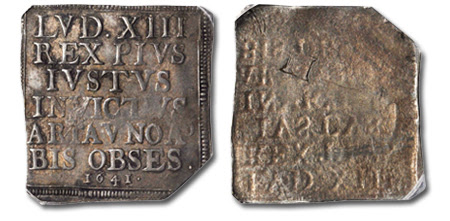
Today’s highlight is an exciting klippe (square or lozenge shaped) coin struck by the French while inhabiting a city under siege. Aire-sur-la-Lys, found in the north of France, came under Spanish control through the Union of Arras in 1579 when it was incorporated into the Spanish Netherlands. During the Franco-Spanish War (1635-59) the Spanish-controlled city was besieged by French troops under the command of Marshal Charles de la Porte Marquis de Meilleraye. To help pay his troops, the Spanish commander melted down his personal silver (as well as silver requisitioned from the nearby church) to produce klippe coinage. Soon after, the French routed the Spanish and took control of the city. Showing great determination, the Spanish attempted to reclaim the city and laid siege to its French occupants. It was at this point, during the second siege in 1641, that klippe coinage was produced in the name of King Louis XIII. This coinage extolled his “pius, just and invincible” virtues.
This coin, from the French occupation of the city, features a seven line inscription on a square planchet: “LVD XIII / REX PIVS / IVSTVS / INVICTVS / ARIAVNOAD / BIS OBSES / 1641.” The reverse is simply the incuse of the obverse design. A small incuse hallmark is found on the reverse which was present on the original silver. Pleasant old toning saturates the surfaces of this historical treasure.

CANADIAN AND U.S. COIN CACHE FOUND IN YUKON
You just don't find pots on ancient Roman coins in North America. But you can still find more modern coin hoards. Here's an account of a recent find in Dawson City, Yukon. Thanks to Dick Hanscom for sending this. -Editor
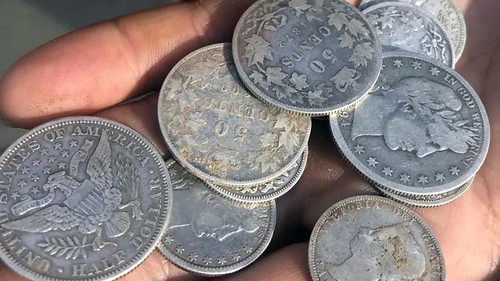
It's been a busy summer for construction in Dawson City, Yukon — which means it's also been busy for the territory's archeologists.
The latest historical find was unearthed last week, as crews were building a new recreational trail. The workers stumbled upon a stack of 23 old Canadian and American coins, buried about 30 centimetres below ground.
They're all from the 19th century, and the oldest is dated 1864.
"These are coins that would have been in common circulation during the [Klondike] Gold Rush," said Christian Thomas, special projects archeologist from the Yukon government.
Yukoner Derek Crowe, who was part of the trail-building crew that found the coins, said he doesn't care much what the coins are worth. He just loves the mystery behind them.
"The questions we're all asking is, 'Who was this person? Why did they leave it? What happened to them?'" Crowe said.
"The real treasure would be if the experts at Yukon Historic Sites and archeology are able to answer some of those questions. That would be just such a wonderful and colourful story to add to this really neat trail."
The coins are now in the Dawson City town safe. Thomas said they may eventually go to the Dawson City Museum, but that hasn't been decided yet.
To read the complete article, see:
Rare find in Dawson City dates to Klondike Gold Rush
(https://www.cbc.ca/news/canada/north/dawson-city-old-coins-1.4811814)
MYRTLEWOOD MONEY OF NORTH BEND, OREGON
Oregon Public Broadcasting published an excellent story this week about North Bend Oregon's Myrtlewood Money, a charming local depression scrip. Here's an excerpt. -Editor
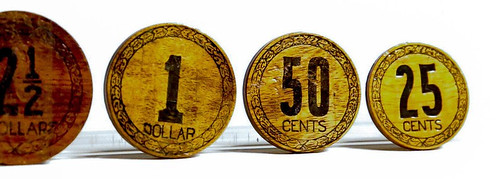
Instead of her first week’s pay, her boss handed over a pair of coins.
“So Duke said … ‘I’ll give you this coin that is more than 2,000 years old — from Europe — and here’s one of these $5 pieces that North Bend used to use — myrtlewood pieces. And you bring those back to me next week and then I’ll give you your salary.’”
Pierce, whose mother was a coin collector, took the coins without any debate. She figured the Roman coin would make a valuable start to her own collection. She had no idea.
The Roman coin turned out to be junk, not worth much due to its pervasiveness. But the myrtlewood coin — a $5 wooden piece given to her in 1948 — she still has it. It’s the anchor piece in her collection of North Bend’s one-of-a-kind currency, known locally as myrtlewood money. A local form of money that is still as good as cash in the boundaries of North Bend.
Myrtlewood money’s story began in the early months of 1933. Life in America was hard in those days. The nation was in the midst of the Great Depression. Banks were foreclosing on farms and homes. Businesses were closing. Unemployment was estimated as high as 25 percent nationwide. And North Bend, a small timber and shipbuilding city on the Coos Bay, was not immune to the nation’s woes.
In early January of that year, the town’s only bank announced a 30-day closure. It was intended as a measure to shore up the institution’s assets. But in the following weeks, no word came about when the bank would reopen.
“The city had to scramble,” said retired North Bend High School teacher and Coos History Museum historian Steve Greif. “It had to pay its employees. It had firemen; it had police officers and city officials, a city manager; and they had to do something.”
On March 10, 1933 — 59 days after the First National Bank closed its doors— the city announced a plan: North Bend would issue its own currency. The city planned to print $1,000 worth of its own scrip to help stimulate the flow of commerce.
This wasn’t an original idea. All across the nation, towns and cities were dealing with a shortage of cash and a run on banks. Communities, municipalities, banks and community organizations began issuing their own currency to stimulate commerce. Most printed their money on paper or even wood. A few places got inventive.
In Morrow County, Oregon, the town of Heppner printed money on strips of sheepskin. In California, the town of Pismo Beach decided to use clamshells as cash. North Bend settled on wood. But not just any wood. A rare type of beautiful hardwood grown locally made this small coastal city’s money a cut above the rest.
“North Bend did it in a beautiful, artistic unique way,” Greif said. “I know other places made wooden money, but I don’t think anybody did it as beautiful as North Bend and did it quite as well.”
North Bend got to work on getting the myrtlewood money into the hands of residents. The city chose a design and began work on issuing the first set of coins. Pressed on 1/4 inch-thick discs of myrtlewood in various diameters, the city’s new coins came in denominations of $10, $5, $2.50, $1 and 50 cents. Then-mayor Edgar McDaniel, who also served as editor of The Coos Bay Harbor, oversaw the printing of the coins on the paper’s presses and their distribution to the public.
It didn’t take long for the myrtlewood money to catch on.
“The newspaper advertised that it was good money, listed all the stores and people and the services in North Bend that would take the money, so it circulated a little bit,” Pierce recounted. City employees and contractors were paid with myrtlewood money, and they, in turn, spent it on goods and services throughout the community.
Demand for the coins was high. Soon, the city decided to issue a second pressing of coins.
Changes were made to the coins for the second issue. The city had learned valuable lessons during the first round of printing and distribution. Most notably, the design on the second issue was more intricate, with details more spread out across the full face of the coin. They also scrapped the $2.50 piece, replacing it with a quarter.
The attention to design proved especially important for myrtlewood money’s fate.
While the coins proved useful in keeping the economy moving, they also were gaining a reputation far and wide for their beauty. The rarity of the wood made counterfeiting the coins difficult, and collectors appreciated the attractiveness of the design.
The coins were so popular that at one point the Klamath Falls Chamber of Commerce discussed the possibility of working with the North Bend Myrtlewood Factory to make money for their city. Collectors across the region clamored for the money. The word was out. The coins’ popularity, however, ultimately led to the currency falling out of circulation.
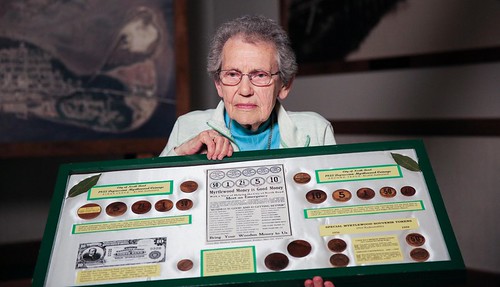
Pat Choat Pierce poses with her collection of the city’s myrtlewood money
“When December came there really weren’t enough people who wanted their money that way,” Pierce said of the coins. “They were keeping it for souvenirs so the money has never been declared finished, even though it had a deadline time printed on it. It is still as good coinage today as it was back in 1933.”
Ultimately, the coins’ beauty made it more valuable as a collectible than a currency.
“That’s the beauty of myrtlewood is that no two coins are alike,” Greif said. “And that’s probably another reason that collectors think of them as being highly unique.”
Nowadays, you’re unlikely to find someone actually willing to use these coins as cash, despite the fact that they remain legal tender within the city limits of North Bend. A $1 piece from the first issue sold in 2016 for $75 — a 7,400 percent premium over its declared value.
“I would say at a minimum the most common are worth from $20 to $30 on the retail market,” said Wagner. “And the more expensive ones get you into the hundreds, and the rarest ones — the $10s — can’t be priced because they’re so rare that they just don’t trade.”
To read the complete article, see:
The Oregon Town Where Money Grows On Trees And Wood Is As Good As
Cash (https://www.opb.org/artsandlife/series/history/myrtlewood-money-north-bend-oregon-great-depression/)
Here are some other articles about Myrtlewood Money. -Editor
Wooden “D.I.Y. dollars” spend like the real thing in North Bend
(http://www.offbeatoregon.com/H1008e_north-bend-myrtlewood-money-still-legal-tender.html)
1933 Myrtlewood Money, North Bend, Oregon Depression Scrip
(http://www.tipsicocoin.com/browse_item.html?category_id=3133&item_id=5894)

ALTCOINS - TODAY'S ALTERNATIVE CRYPTOCOINS
Dave Bowers forwarded this article from the September 1, 2018 issue of The Economist about the many new cryptocurrencies springing up in Bitcoin's wake. The article appeared in the Technology Quarterly section of the print edition under the headline "Chips off the block". Thanks. -Editor
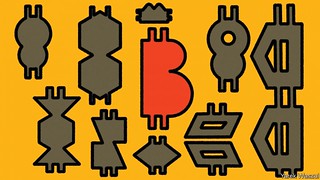 BITCOIN FANS like to point out that, like gold, the cryptocurrency is in limited supply. Its protocol specifies that only 21m bitcoin will ever be mined, with the last
batch due in the middle of the 22nd century. A fixed supply, say bitcoiners, ensures that, unlike ordinary currencies, it will not be eroded by inflation.
BITCOIN FANS like to point out that, like gold, the cryptocurrency is in limited supply. Its protocol specifies that only 21m bitcoin will ever be mined, with the last
batch due in the middle of the 22nd century. A fixed supply, say bitcoiners, ensures that, unlike ordinary currencies, it will not be eroded by inflation.
But whereas the supply of bitcoin may be limited, that of cryptocurrencies is not. Bitcoin’s protocol is open-source, so there is nothing to stop others copying the idea. And they have done, with gusto. So far thousands of different cryptocurrencies have been launched. Like bitcoin, they have proved attractive to speculators. For example, XRP, issued by Ripple, a payments firm, rose from less than one cent to touch $3.46 in January this year (it has since dropped back to around $0.35). The magnitudes vary, but the price movements of cryptocurrencies tend to be correlated. When bitcoin is rising, the so-called “altcoins” tend to rise as well, and vice versa.
Zcash, Dash and Monero are all cryptocurrencies that aim to give users more privacy. Monero, in particular, quickly became a popular alternative to bitcoin in some of the less salubrious corners of the internet. “Stablecoins” such as Basis, Carbon and Tether, meanwhile, attempt to tame the volatility that makes cryptocurrencies attractive to speculators.
Many cryptocurrencies, though, go nowhere. Deadcoins.com, a site that keeps track of moribund ones, lists about 900 coins that have been abandoned by their creators or their users.
To read the complete article, see:
From one cryptocurrency to thousands
(https://www.economist.com/technology-quarterly/2018/09/01/from-one-cryptocurrency-to-thousands)
DISCOVERY: AUSTRALIA MINTS HOLEY DOLLAR TRIBUTE
The Perth Mint has created a very pricey tribute coin honoring Australia's famous Holey Dollar. -Editor
Australia has minted a gold coin encrusted with rare pink diamonds worth Aus$2.48 million (US$1.8 million) to meet growing demand for high-end collectables from the ultra-rich.
The two-kilogramme treasure, which depicts a sailing ship, a gold prospector and boab trees found in Western Australia, is considered legal tender and will be sold to the highest bidder.
It is the most valuable coin ever made in Australia and is expected to be sold to a buyer from Asia or the Middle East.
It was "released in response to the distinct increase in demand for exclusive luxury items", said Perth Mint chief executive Richard Hayes Tuesday.
"The coin showcases rare pink stones handset in the most famed of precious metals, telling the inspirational rags to riches tales of mining for these prized resources."
Called "Discovery", it was modelled after the "Holey Dollar", one of Australia's first coins, with a private collector paying Aus$495,000 for one of those in 2013.
A key attraction is the four pink diamonds from the renowned Argyle mine in Australia's remote western Kimberley region, including a 1.02-carat emerald cut.
"In terms of pink diamonds themselves, you can fit the whole year's production literally into the palm of your hand," said Hayes.
Miner Rio Tinto holds a pink diamond sale each year which attracts global interest. Stones can fetch US$1-2 million a carat.
As a basic rule of thumb, pink and red diamonds are worth about 50 times more than white diamonds.
To read the complete article, see:
Australia Mints Its Most Valuable Gold Coin Ever
(https://www.ndtv.com/world-news/australia-mints-its-most-valuable-gold-coin-ever-1910986)
THE BOOK BAZARRE
THE PERTH MINT RARE EARTH COIN
Once in a while a new product release catches my eye. I like the toning and unusual design of this piece from Australia's Perth Mint. Here's an excerpt from the press release. -Editor
RARE EARTH
2018 5oz SILVER HIGH RELIEF PATINA COIN
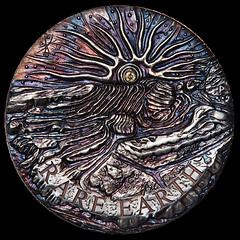 Blending some of the world’s oldest and rarest elements The Perth Mint has applied its expertise to present a magnificent example of its artistry.
Blending some of the world’s oldest and rarest elements The Perth Mint has applied its expertise to present a magnificent example of its artistry.
Born of supernovas, precious metals such as silver were present in the cloud of galactic dust that coalesced to create our solar system. A supernova occurs during the final stages of a star’s life cycle and culminates in an explosion of titanic proportions.
Rare and brilliant, diamonds have been a source of intense fascination for centuries. After forming billions of years ago they remained deep in the Earth’s mantle before being catapulted closer to the surface by rapidly ascending streams of molten volcanic rock.
The unique and naturally coloured golden diamond featured in this coin, aged at 1.6 billion years, has been extracted from the Argyle Diamond Mine in Western Australia’s spectacular Kimberley region.
Struck by The Perth Mint from 5oz of 99.99% pure silver and featuring a handset Argyle golden diamond, the coin is issued as legal tender under the Australian Currency Act 1965.
The Perth Mint will release no more than 1,000 of the Rare Earth 2018 5oz Silver High Relief Patina Coin.
DESIGN
Sculpted in pure silver, the coin’s reverse depicts an artistic representation of a star exploding into a supernova with a handset golden diamond at its centre. The design
includes an interpretation of lava flowing from a volcano and forming the layers of the Argyle Diamond Mine, representing the origin of the precious jewel. The design also
incorporates the inscription RARE EARTH and The Perth Mint’s ‘P’ mintmark.
The Ian Rank-Broadley effigy of Her Majesty Queen Elizabeth II, the 2018 year-date, the weight and fineness, and the monetary denomination are depicted on the coin’s obverse.
PATINA FINISH
Reflecting the timeless nature of the elements from which it has been crafted, the coin has been individually oxidised to give it a unique patina effect conveying the surface of
an aged artefact. As a result of this specialised treatment the appearance and subtle colouration of each coin will vary.
For more information, see:
https://www.perthmint.com/
HEDY LAMARR JEWISH-AMERICAN HALL OF FAME MEDAL
Mel Wacks of Woodland Hills, CA writes:
It’s hard to believe that I have been coordinating the Jewish-American Hall of Fame medals since 1969. I am pleased to send you news about the 49th medal issued in this series, honoring "The World's Most Beautiful Woman," who also may have been one of the smartest--Hedy Lamarr.
As a student of the history of business, science and technology, I have a soft spot for Hedy Lamarr as well. If you're not familiar with her story, you should be. Here are images of the medal, which was produced by The Highland Mint. The reverse features a portion of Hedy Lamarr's patent. -Editor
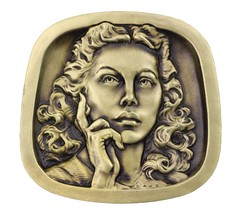

Photos courtesy Eugene Daub
Hedy Lamarr (neé Hedwig Eva Maria Kiesler) was born to Jewish parents in 1914 in Vienna. In early 1933, at age 18, she starred in the movie Ecstasy, where she gained worldwide fame for a brief nude scene.
After she met Louis B. Mayer in Paris, he persuaded her to change her name to Hedy Lamarr and brought her to Hollywood. Lamarr made her American film debut in Algiers (1938), opposite Charles Boyer. According to one viewer, when her face first appeared on the screen, "everyone gasped—Lamarr's beauty literally took one's breath away." Hedy made 18 films from 1940 to 1949. After leaving MGM in 1945, she enjoyed her biggest success as Delilah in Cecil B. DeMille's Samson and Delilah, the highest-grossing film of 1949. Hedy Lamarr has a star on the Hollywood Walk of Fame at 6247 Hollywood Boulevard, adjacent to Vine Street.
During World War II, Lamarr learned that radio-controlled torpedoes could easily be jammed, thereby causing the torpedo to go off course. With the knowledge she had gained about torpedoes from her first husband, she thought of creating a frequency-hopping signal that could not be tracked or jammed. She contacted her friend, composer and pianist George Antheil, to help her develop a device for doing that, and he succeeded by synchronizing a miniaturized player-piano mechanism with radio signals. They drafted designs for the frequency-hopping system, which they patented. However, it was technologically difficult to implement, and at that time the U.S. Navy was not receptive to considering inventions coming from outside the military—especially from a movie star.
Rather, Lamarr used her celebrity status to sell war bonds. Under an arrangement in which she would kiss anyone who purchased $25,000 worth of bonds, she sold $7 million worth in one night.
It wasn’t until the 1950s that engineers began experimenting with ideas documented in Lamarr and Antheil’s system.Their work with spread spectrum technology contributed to the development of GPS, Bluetooth, and Wi-Fi. So, whenever anyone uses their cell-phone or GPS he or she should think of Hedy.
Limited edition 2-inch, 3-oz. medals, designed by Eugene Daub, have been minted in honor of Hedy Lamarr—120 in bronze, 60 in pure silver, and 30 in gold-plated pure silver. Only a handful of bronze medals are available for $50 each. Order by calling 818-225-1348. Mention that you read about it in The E-Sylum, and take a 10% discount.
The Medal Collectors of America have a handy guide to the Jewish-American hall of Fame medal series on their web site. -Editor
To read the MCA Guide, see:
Jewish-American Hall of Fame Collector's Guide
(https://www.medalcollectors.org/Guides/J-AHF/J-AHF.html)
For more information on the Jewish-American Hall of Fame, see:
http://www.amuseum.org/jahf/
SAN DIEGO NEWSPAPER COVERS $20 BROWNBACK SALE
The San Diego Union Tribune published an article on the upcoming sale of a $20 Brownback National Bank Note from the Consolidated National Bank of San Diego. here's an excerpt. -Editor

A $20 bill issued 136 years ago by a long-departed San Diego bank is worthless as currency — and potentially priceless as a collectible.
While this 1882 “brownback” from the Consolidated National Bank of San Diego is not legal tender, it is prized by collectors. In 2000, it sold for $27,500.
A far greater price is expected today when the bill is auctioned at the annual Long Beach Expo Coin, Currency, Stamp and Sports Collectible Show.
“The estimate on this is $100,000 to $125,000,” said Eric Bradley of Heritage Auctions, which will oversee the bidding.
Elaborately engraved in greens, reds and russet brown, the bill is a relic of a defunct institution — Consolidated National folded in 1893 — and a vanished era. Throughout the 19th century, it was common for American banks to print their own money.
“Unfortunately,” said Dustin Johnson, Heritage’s currency expect, “that money was only as good as the bank and its owners. Since most banks were locally owned, the further one got the from the bank, the less the money was worth.
“Even in the next town over, a note would be heavily discounted based on a lack of knowledge regarding that bank’s finances, or even if it was still in business.”
One solution devised by Washington: “National Banks.” Each was allowed to buy $25,000 in bonds, depositing the money with the U.S. Treasury. In exchange, the banks could issue $25,000 of their own currency, which would be accepted at all of the 12,000 National Banks.
Then came the Panic of 1893, a nationwide depression that wiped out many banks, including five of San Diego’s eight banks. Consolidated National was wiped out and its president, Judge Oliver S. Witherby, lost most of his fortune.
Curious about the "not legal tender" part, I reached out to National Bank Note researcher Peter Huntoon. His response is in the next article in this issue. -Editor
To read the complete article, see:
For a worthless $20 bill from a bygone San Diego bank, the bidding begins at
$50,000 (http://www.sandiegouniontribune.com/news/sd-me-currency-auction-20180831-story.html)
NATIONAL BANK NOTE LEGAL TENDER STATUS
Peter Huntoon submitted this article in response to my question to him about the legal tender status of National Bank Notes (see the previous article in the current issue of The E-Sylum. -Editor
It is a peculiar fact that national bank notes were not accorded legal tender status by the National Bank Acts of 1863 and 1864. However, the law was explicit that they were redeemable in "lawful money," which was defined as legal tender currency. Consequently they always have been accepted by all as equivalent to legal tender (United States) notes. As the price of legal tender notes fluctuated during the Civil war, the price of nationals tracked it in lock-step. When Congress decreed that species payments would resume on January 1, 1879, both the value of legal tender notes and nationals converged on the gold dollar at that time and remained there for the duration.
There is an interesting twist to this story. The extraordinary Agricultural Adjustment Act passed on May 12, 1933, during the early days of FDRs New Deal, contained a provision that obliterated the distinctions between the various classes of coinage and currency issued under the authority of Congress. Title III, section 43, of that act states: "Such notes and all other coins and currencies heretofore or hereafter coined or issued by or under the authority of the United shall be legal tender for all debts public and private." National bank notes fell under this umbrella so from that time forward they have carried legal tender status.
Notice on the attached proof for the unissued Series of 1929A national bank notes that the redemption clause reads: "Redeemable in Lawful Money of the United States at United States Treasury or at the bank of Issue." Thanks to the Agricultural Adjustment Act, this clause was modified on the model dated May 23 1934 to read "This bank note is legal tender for all debts, public and private and is redeemable in lawful money of the United States at United States Treasury or at the bank of issue."
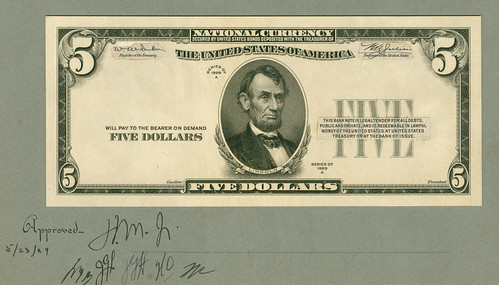
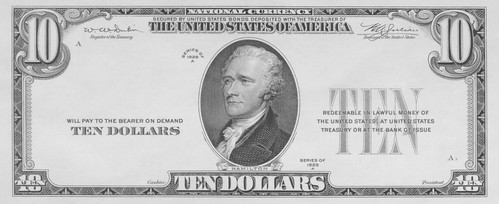
INDIA CONSIDERS VARNISHED BANKNOTES
Once upon a time collectors would apply a coat of lacquer to their coins to help preserve them. But varnished banknotes? The Reserve Bank of India is considering varnishing their notes. -Editor
You have heard of money laundering but what about money 'varnishing'? You have heard of laundered notes but what about 'varnished notes'? RBI proposes to launch varnished banknotes on a field trial basis, as per its annual report for FY17-18 released today.
RBI's annual report says: "In consultation with the Government of India, the Reserve Bank has been exploring the feasibility of increasing the life of Indian banknotes. International experience suggests that varnishing of banknotes is expected to increase their life and durability, reduce the banknote replacement requirements and thereby lower the overall security printing expenditure. It is proposed to introduce varnished banknotes on a field trial basis." Few countries like Kenya and Bank of Zambia already have such banknotes in circulation.
To read the complete article, see:
RBI proposal: Varnished
banknotes in your wallet soon
(https://economictimes.indiatimes.com/wealth/personal-finance-news/rbi-proposal-varnished-banknotes-in-your-wallet-soon/articleshow/65593850.cms)
Thanks to the September 4, 2018 issue of News & Notes from the Society of Paper Money Collectors for the story. Varnishing banknotes is not an upcommon practice. Here's one reference from the Bank of Mexico. -Editor
Besides differences in the performance of the substrate in the printing machines, polymer banknotes must be varnished, a process which had to be modified to take account of Mexico City’s height of more than two thousand meters above sea level which affects how varnish dries. These technical problems which arose during the printing tests were all resolved, and so the project remained economically viable.
To read the complete article, see:
The use of polymer in Banco de México banknotes
(http://www.banxico.org.mx/banknotes-and-coins/d/%7B323357DF-7069-AEC2-09F0-7119784E0872%7D.pdf)
LOOSE CHANGE: SEPTEMBER 9, 2018
Here are some additional items I came across in the media this week that may be of interest. -Editor
Inverted Jenny No. 49 Reappears
This New York Times article reports the discovery of a long-missing Inverted Jenny stamp. -Editor
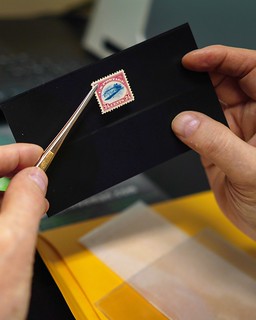 When the phone rings at the nonprofit Philatelic Foundation in Manhattan, sometimes it is a caller claiming to have a rare stamp and wanting the foundation to
authenticate it.
When the phone rings at the nonprofit Philatelic Foundation in Manhattan, sometimes it is a caller claiming to have a rare stamp and wanting the foundation to
authenticate it.
In the internet age, the people at the foundation can ask for a cellphone photo of the stamp in question. Usually someone from the foundation calls back and says something like, “Sorry, your stamp is not what you think it is. It’s not that special.”
But a recent call from Illinois got their attention. The man on the phone said he had one of the most famous stamps in the world, an Inverted Jenny with — oops — the airplane upside down. When the man sent a cellphone photo, the foundation’s curator, Lewis Kaufman, suspected the stamp was an Inverted Jenny that disappeared from sight soon after it was printed in 1918. Only 100 Inverted Jenny stamps exist. Mr. Kaufman suspected it was No. 49, one of only two that remained unaccounted for.
He handed the photo to his boss, Larry Lyons, and said, “I think it might be genuine. You ought to call this guy back.”
To read the complete article, see:
An Inverted Jenny Surfaces. The Flawed Stamp Had Not Been Seen Since 1918.
(https://www.nytimes.com/2018/09/06/nyregion/inverted-jenny-stamp.html)
Dave Bowers' Moxie Memorabilia
It's not unusual for numismatists to have additional collecting hobbies. Author Dave Bowers collects Moxie memorabilia. Here's an article from the New Hampshire Union Leader published September 7, 2018. Cool photo! -Editor
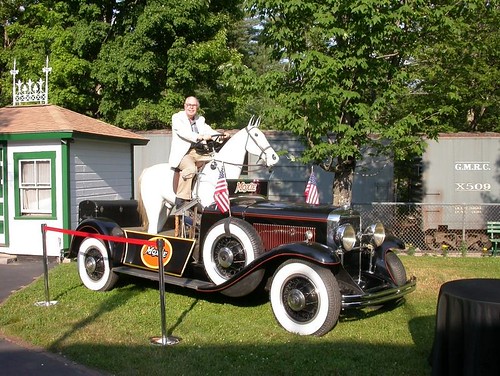
The quintessential spirit of Moxie is not easily defined, but sit down with Q. David Bowers and you'll find a good approximation - an effervescent personality whose sharp mind is as "decidedly different" as his favorite soda advertises.
The author of more than 50 books - many on coins, not to overlook his three-volume "History of Wolfeboro, New Hampshire" - Bowers combines his business acumen, his tenacity as a researcher and his love of language in producing works that become recognized as standards references in their field including "The Moxie Encyclopedia."
Bowers says his interest in Moxie memorabilia was sparked by Eddie Clark of Clark's Trading Post in Lincoln in the early 1970s, although he had acquired a few hand fans emblazoned with Moxie girls and other collectibles about a decade earlier.
To read the complete article, see:
The Moxie machine: Soda's heavy marketing created a trove of
memorabilia (http://www.unionleader.com/The-Moxie-machine:-Sodas-heavy-marketing-created-a-trove-of-memorabilia)

